Sexism

Sexism

セクシズムとは性別(sexual difference)にもとづく差別のことをいう。したがって長く、性差別主義とも呼ばれてきた。この言い方は、人種主義(レイシズム)が、人種差別主義と同義であることと同じである。
性別には、ジェンダーとセッ クスと いう、社会的性別と生物学的性別の2つの区別があるが、ジュディス・バトラーらの主張によると、我々は社会的存在であり、いくら自然科学の客観・中立な立 場を表向き取ろうとも、研究者ですら、日常の社会的性別(ジェンダー)の認識論的枠組みの影響を受けているため、言語という社会的コミュニケーションを とっている限り、セックス(生物学的性別)は、当該社会におけるジェンダー区分の影響やイデ オロギーから自由になれないだろうという。また、そのような議論の枠組みを踏襲すれば、社会的性別ないしは文化的性別(ともにジェンダー)すら、生物学的性別(セッ クス)の峻別や、それらの差異についてのメタファーを生物学的性別の概念から借りてくるために、ジェンダーとセックスの境界における明確な峻別が可能であると主張することも幻想である。 社会的性別は、生物学的性別の影響を受け形成し、生物学的性別は社会的性別の概念形成に影響を与えているからである。
セクシズムという言葉は、1960年代の
北米大陸のフェミニズム運動のなかで、性に基づく差別構造、とりわけ女性への社会的構造的抑圧への批判
を込めて誕生したことは忘れてはならないだろう。
【設問】
1.セクシズムがしばしば「犠牲者非難」のなかで登場するが、そのことを実例をまじ えながら表現することができるか?
2.セクシズムは性別をとりあげて非難す
ることだけではなく、雇用の現場で、女性やクイアをしらないうちに男性と区別して後者をしらないうちに優遇するような「性差別(性別に基づく差別)」の現場でよくあらわれます。みなさ
んの職場において性差別がないか点検してみましょう。
★セクシズム(Sexism)
| Sexism
is prejudice or discrimination based on one's sex or gender. Sexism can
affect anyone, but primarily affects women and girls.[1] It has been
linked to gender roles and stereotypes,[2][3] and may include the
belief that one sex or gender is intrinsically superior to another.[4]
Extreme sexism may foster sexual harassment, rape, and other forms of
sexual violence.[5][6] Discrimination in this context is defined as
discrimination toward people based on their gender identity[7] or their
gender or sex differences.[8] An example of this is workplace
inequality.[8] Sexism refers to violation of equal opportunities
(formal equality) based on gender or refers to violation of equality of
outcomes based on gender, also called substantive equality.[9] Sexism
may arise from social or cultural customs and norms.[10] |
性差別とは、性別や性自認に基づく偏見や差別を指す。性差別は誰にでも
影響を及ぼす可能性があるが、主に女性や少女に影響を及ぼす。[1] 性差別はジェンダーの役割や固定観念と関連しており、[2][3]
ある性別や性自認が本質的に他よりも優れているという信念を含む場合がある。[4]
極端な性差別は、セクハラやレイプ、その他の性的暴力を助長する可能性がある。[5][6] この文脈における差別とは、
性自認[7]または性別や性差に基づく人々に対する差別と定義される。[8] その例としては職場における不平等が挙げられる。[8]
セクシズムとは、性別に基づく機会均等(形式的な平等)の侵害を指すか、または性別に基づく結果の平等の侵害を指し、実質的平等とも呼ばれる。[9]
セクシズムは、社会的または文化的慣習や規範から生じる可能性がある。[10] |
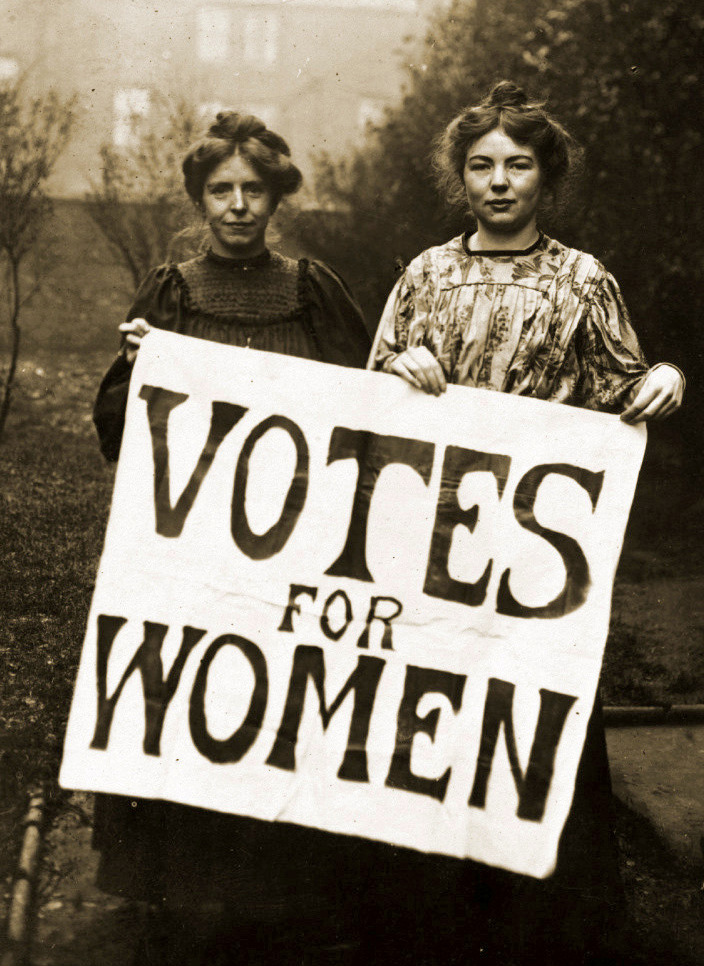  Suffragette organizations campaigned for women's right to vote.1914 |
  女性参政権を求める運動が展開された。1914年 |
| Etymology and definitions According to legal scholar Fred R. Shapiro, the term "sexism" was most likely coined on November 18, 1965, by Pauline M. Leet during a "Student-Faculty Forum" at Franklin and Marshall College. Specifically, the word sexism appears in Leet's forum contribution "Women and the Undergraduate", and she defines it by comparing it to racism, stating in part, "When you argue ... that since fewer women write good poetry this justifies their total exclusion, you are taking a position analogous to that of the racist—I might call you, in this case, a 'sexist' ... Both the racist and the sexist are acting as if all that has happened had never happened, and both of them are making decisions and coming to conclusions about someone's value by referring to factors which are in both cases irrelevant."[11] According to the Oxford English Dictionary, the first time the term sexism appeared in print was in Caroline Bird’s speech "On Being Born Female", which was delivered before the Episcopal Church Executive Council in Greenwich, Connecticut, and subsequently published on November 15, 1968, in Vital Speeches of the Day (p. 6).[12] Sexism may be defined as an ideology based on the belief that one sex is superior to another.[4][13][14] It is discrimination, prejudice, or stereotyping based on gender, and is most often expressed toward women and girls.[1] Sociology has examined sexism as manifesting at both the individual and the institutional level.[14] According to Richard Schaefer, sexism is perpetuated by all major social institutions.[14] Sociologists describe parallels among other ideological systems of oppression such as racism, which also operates at both the individual and institutional level.[15] Early female sociologists Charlotte Perkins Gilman, Ida B. Wells, and Harriet Martineau described systems of gender inequality, but did not use the term sexism, which was coined later. Sociologists who adopted the functionalist paradigm, e.g. Talcott Parsons, understood gender inequality as the natural outcome of a dimorphic model of gender.[16] Psychologists Mary Crawford and Rhoda Unger define sexism as prejudice held by individuals that encompasses "negative attitudes and values about women as a group."[17] Peter Glick and Susan Fiske coined the term ambivalent sexism to describe how stereotypes about women can be both positive and negative, and that individuals compartmentalize the stereotypes they hold into hostile sexism or benevolent sexism.[18] Feminist author bell hooks defines sexism as a system of oppression that results in disadvantages for women.[19] Feminist philosopher Marilyn Frye defines sexism as an "attitudinal-conceptual-cognitive-orientational complex" of male supremacy, male chauvinism, and misogyny.[20] Philosopher Kate Manne defines sexism as one branch of a patriarchal order. In her definition, sexism rationalizes and justifies patriarchal norms, in contrast with misogyny, the branch which polices and enforces patriarchal norms. Manne says that sexism often attempts to make patriarchal social arrangements seem natural, good, or inevitable so that there appears to be no reason to resist them.[21] |
語源と定義 法律学者のフレッド・R・シャピロ氏によると、「性差別」という用語は、1965年11月18日にフランクリン・アンド・マーシャル大学で開催された「学 生と教職員のフォーラム」において、ポーリン・M・リート氏によって初めて使用された可能性が高い。具体的には、リー氏のフォーラムへの投稿「女性と学部 生」に「性差別」という言葉が使われており、彼女は人種主義と比較しながら次のように定義している。「女性が優れた詩を書くことが少ないからといって、彼 女たちを完全に排除することが正当化されると主張するなら、あなたは人種差別主義者と類似した立場を取っていることになる。この場合、私はあなたを『性差 別主義者』と呼ぶかもしれない。人種差別主義者も性差別主義者も、あたかも何も起こらなかったかのように振る舞い、どちらも、どちらの場合も無関係な要因 を参照して、誰かの価値について決定を下し結論を出している」[11] オックスフォード英語辞典によると、性差別という用語が印刷物に初めて登場したのは、コネチカット州グリニッジの聖公会執行協議会で発表されたキャロライ ン・バードの演説「女性として生まれて」であり、その後、1968年11月15日に『Vital Speeches of the Day』(p. 6)に掲載された。[12] 性差別とは、一方の性が他方より優れているという信念に基づくイデオロギーと定義されることがある。[4][13][14] 性差別とは、性別に基づく差別、偏見、または固定観念であり、女性や少女に対して最も頻繁に表れる。[1] 社会学では、性差別は個人レベルと制度レベルの両方で現れるものとして研究されている。[14] リチャード・シェーファーによると、性差別はすべての主要な社会制度によって永続化されている。[14] 社会学者は、人種主義などの他の抑圧的イデオロギー体系との類似点を指摘している 。これもまた個人と制度の両方のレベルで作用している。[15] 初期の女性社会学者であるシャーロット・パーキンス・ギルマン、アイダ・B・ウェルズ、ハリエット・マーティノーは、ジェンダーの不平等なシステムについ て説明したが、後に作られた「性差別」という用語は使用しなかった。機能主義的パラダイムを採用した社会学者、例えばタルコット・パーソンズは、ジェン ダーの不平等をジェンダーの二形モデルの自然な帰結として理解していた。[16] 心理学者のメアリー・クロフォードとローダ・ウンガーは、性差別を「女性という集団に対する否定的な態度や価値観」を含む個人による偏見と定義している。 [17] ピーター・グリックとスーザン・フィスクは、女性に対するステレオタイプが肯定的にも否定的にもなりうることを説明するために「アンビヴァレント・セクシ ズム」という用語を考案した。また、個人が抱くステレオタイプを敵対的性差別と好意的性差別に区分する。[18] フェミニストの著述家ベル・フックスは、性差別を女性にとって不利益をもたらす抑圧の体系と定義している。[19] フェミニストの哲学者マリリン・フライは、性差別を男性至上主義、男性中心主義、女性嫌悪の「態度・概念・認知・志向の複合体」と定義している。[20] 哲学者のケイト・マンは、性差別を家父長制の一形態と定義している。彼女の定義では、性差別は家父長制の規範を合理化し正当化するものであり、家父長制の 規範を監視し強制する役割である女性嫌悪とは対照的である。マンは、性差別はしばしば家父長制の社会的取り決めを自然で良いもの、あるいは不可避なものと して見せかけ、それらに抵抗する理由がないように見せかけると述べている。[21] |
| History Pre-agricultural world Evidence is lacking to support the idea that many pre-agricultural societies afforded women a higher status than women today,[22] however, historians are reasonably sure that women had roughly equal social power to men in many such societies.[23] Ancient civilizations  Engraving of a woman preparing to self-immolate with her husband's corpse Sati, or self-immolation by widows, was prevalent in Hindu society until the early 19th century. After the adoption of agriculture and sedentary cultures, the concept that one gender was inferior to the other was established; most often this was imposed upon women and girls.[24] The status of women in ancient Egypt depended on their fathers or husbands, but they had property rights and could attend court, including as plaintiffs.[25] Examples of unequal treatment of women in the ancient world include written laws preventing women from participating in the political process; for instance, women in ancient Rome could not vote or hold political office.[26] Another example is scholarly texts that indoctrinate children in female inferiority; women in ancient China were taught the Confucian principles that a woman should obey her father in childhood, husband in marriage, and son in widowhood.[27] On the other hand, women of the Anglo-Saxon era were commonly afforded equal status.[28] Witch hunts and trials Main article: Witch hunt  Titlepage from the book Malleus Maleficarum "The Hammer of Witches which destroyeth Witches and their heresy as with a two-edged sword". Title page of the seventh Cologne edition of the Malleus Maleficarum, 1520, from the University of Sydney Library.[29] Sexism may have been the impetus that fueled the witch trials between the 15th and 18th centuries.[30] In early modern Europe, and in the European colonies in North America, claims were made that witches were a threat to Christendom. The misogyny of that period played a role in the persecution of these women.[31][32] In Malleus Maleficarum by Heinrich Kramer, the book which played a major role in the witch hunts and trials, the author argues that women are more likely to practice witchcraft than men, and writes that: All wickedness is but little to the wickedness of a woman ... What else is a woman but a foe to friendship, an inescapable punishment, a necessary evil, a natural temptation, a desirable calamity, a domestic danger, a delectable detriment, an evil of nature, painted with fair colors![33] Witchcraft remains illegal in several countries, including Saudi Arabia, where it is punishable by death. In 2011, a woman was beheaded in that country for "witchcraft and sorcery".[34] Murders of women after being accused of witchcraft remain common in some parts of the world; for example, in Tanzania, about 500 elderly women are murdered each year following such accusations.[35] When women are targeted with accusations of witchcraft and subsequent violence, it is often the case that several forms of discrimination interact – for example, discrimination based on gender with discrimination based on caste, as is the case in India and Nepal, where such crimes are relatively common.[36][37] Coverture and other marriage regulations Main articles: Coverture, Marital power, Restitution of conjugal rights, Kirchberg v. Feenstra, and Marriage bar  An Indian Anti-dowry poster headed Say No To Dowry Anti-dowry poster in Bangalore, India. According to Amnesty International, "[T]he ongoing reality of dowry-related violence is an example of what can happen when women are treated as property."[38] Until the 20th century, U.S. and English law observed the system of coverture, where "by marriage, the husband and wife are one person in law; that is the very being or legal existence of the woman is suspended during the marriage".[39] U.S. women were not legally defined as "persons" until 1875 (Minor v. Happersett, 88 U.S. 162).[40] A similar legal doctrine, called marital power, existed under Roman Dutch law (and is still partially in force in present-day Eswatini).[citation needed] Restrictions on married women's rights were common in Western countries until a few decades ago: for instance, French married women obtained the right to work without their husband's permission in 1965,[41][42][43] and in West Germany women obtained this right in 1977.[44][45] During the Franco era, in Spain, a married woman required her husband's consent (called permiso marital) for employment, ownership of property and traveling away from home; the permiso marital was abolished in 1975.[46] In Australia, until 1983, a married woman's passport application had to be authorized by her husband.[47] Women in parts of the world continue to lose their legal rights in marriage. For example, Yemeni marriage regulations state that a wife must obey her husband and must not leave home without his permission.[48] In Iraq, the law allows husbands to legally "punish" their wives.[49] In the Democratic Republic of Congo, the Family Code states that the husband is the head of the household; the wife owes her obedience to her husband; a wife has to live with her husband wherever he chooses to live; and wives must have their husbands' authorization to bring a case in court or initiate other legal proceedings.[50] Abuses and discriminatory practices against women in marriage are often rooted in financial payments such as dowry, bride price, and dower.[51] These transactions often serve as legitimizing coercive control of the wife by her husband and in giving him authority over her; for instance Article 13 of the Code of Personal Status (Tunisia) states that, "The husband shall not, in default of payment of the dower, force the woman to consummate the marriage",[52][53] implying that, if the dower is paid, marital rape is permitted. In this regard, critics have questioned the alleged gains of women in Tunisia, and its image as a progressive country in the region, arguing that discrimination against women remains very strong there.[54][55][56] The World Organisation Against Torture (OMCT) has recognized the "independence and ability to leave an abusive husband" as crucial in stopping mistreatment of women.[57] However, in some parts of the world, once married, women have very little chance of leaving a violent husband: obtaining a divorce is very difficult in many jurisdictions because of the need to prove fault in court. While attempting a de facto separation (moving away from the marital home) is also impossible because of laws preventing this. For instance, in Afghanistan, a wife who leaves her marital home risks being imprisoned for "running away".[58][59] In addition, many former British colonies, including India, maintain the concept of restitution of conjugal rights,[60] under which a wife may be ordered by court to return to her husband; if she fails to do so, she may be held in contempt of court.[61][62] Other problems have to do with the payment of the bride price: if the wife wants to leave, her husband may demand the return of the bride price that he had paid to the woman's family; and the woman's family often cannot or does not want to pay it back.[63][64][65] Laws, regulations, and traditions related to marriage continue to discriminate against women in many parts of the world, and to contribute to the mistreatment of women, in particular in areas related to sexual violence and to self-determination regarding sexuality, the violation of the latter now being acknowledged as a violation of women's rights. In 2012, Navi Pillay, then High Commissioner for Human Rights, stated that: Women are frequently treated as property, they are sold into marriage, into trafficking, into sexual slavery. Violence against women frequently takes the form of sexual violence. Victims of such violence are often accused of promiscuity and held responsible for their fate, while infertile women are rejected by husbands, families and communities. In many countries, married women may not refuse to have sexual relations with their husbands, and often have no say in whether they use contraception ... Ensuring that women have full autonomy over their bodies is the first crucial step towards achieving substantive equality between women and men. Personal issues—such as when, how and with whom they choose to have sex, and when, how and with whom they choose to have children—are at the heart of living a life in dignity.[66] Suffrage and politics  Two woman carry a sign reading "Votes for Women". Annie Kenney and Christabel Pankhurst Gender has been used as a tool for discrimination against women in the political sphere. Women's suffrage was not achieved until 1893, when New Zealand was the first country to grant women the right to vote. Saudi Arabia is the most recent country, as of August 2015, to extend the right to vote to women in 2011.[67] Some Western countries allowed women the right to vote only relatively recently. Swiss women gained the right to vote in federal elections in 1971,[68] and Appenzell Innerrhoden became the last canton to grant women the right to vote on local issues in 1991, when it was forced to do so by the Federal Supreme Court of Switzerland.[69] French women were granted the right to vote in 1944.[70][71] In Greece, women obtained the right to vote in 1952.[72] In Liechtenstein, women obtained the right to vote in 1984, through the women's suffrage referendum of 1984.[73][74] While almost every woman today has the right to vote, there is still progress to be made for women in politics. Studies have shown that in several democracies including Australia, Canada, and the United States, women are still represented using gender stereotypes in the press.[75] Multiple authors have shown that gender differences in the media are less evident today than they used to be in the 1980s, but are still present. Certain issues (e.g., education) are likely to be linked with female candidates, while other issues (e.g., taxes) are likely to be linked with male candidates.[75] In addition, there is more emphasis on female candidates' personal qualities, such as their appearance and their personality, as females are portrayed as emotional and dependent.[75] There is a widespread imbalance of lawmaking power between men and women. The ratio of women to men in legislatures is used as a measure of gender equality in the United Nations' Gender Empowerment Measure and its newer incarnation the Gender Inequality Index. Speaking about China, Lanyan Chen stated that, since men more than women serve as the gatekeepers of policy making, this may lead to women's needs not being properly represented. In this sense, the inequality in lawmaking power also causes gender discrimination.[76] Menus Until the early 1980s, some high-end restaurants had two menus: a regular menu with the prices listed for men and a second menu for women, which did not have the prices listed (it was called the "ladies' menu"), so that the female diner would not know the prices of the items.[77] In 1980, Kathleen Bick took a male business partner out to dinner at L'Orangerie in West Hollywood. After she was given a women's menu without prices and her guest got one with prices, Bick hired lawyer Gloria Allred to file a discrimination lawsuit, on the grounds that the women's menu went against the California Civil Rights Act.[77] Bick stated that getting a women's menu without prices left her feeling "humiliated and incensed". The owners of the restaurant defended the practice, saying it was done as a courtesy, like the way men would stand up when a woman enters the room. Even though the lawsuit was dropped, the restaurant ended its gender-based menu policy.[77] Trends over time Globe icon. The examples and perspective in this section may not represent a worldwide view of the subject. You may improve this section, discuss the issue on the talk page, or create a new section, as appropriate. (March 2021) (Learn how and when to remove this message) A 2021 study found little evidence that levels of sexism had changed from 2004 to 2018 in the United States.[78] Gender stereotypes See also: Gender role § Gender stereotypes, and Implicit stereotype § Gender stereotypes  Series of photographs lampooning women drivers Bettie Page portrays stereotypes about women drivers in 1952. Gender stereotypes are widely held beliefs about the characteristics and behavior of women and men.[79] Empirical studies have found widely shared cultural beliefs that men are more socially valued and more competent than women in a number of activities.[80][81] Dustin B. Thoman and others (2008) hypothesize that "[t]he socio-cultural salience of ability versus other components of the gender-math stereotype may impact women pursuing math". Through the experiment comparing the math outcomes of women under two various gender-math stereotype components, which are the ability of math and the effort on math respectively, Thoman and others found that women's math performance is more likely to be affected by the negative ability stereotype, which is influenced by sociocultural beliefs in the United States, rather than the effort component. As a result of this experiment and the sociocultural beliefs in the United States, Thoman and others concluded that individuals' academic outcomes can be affected by the gender-math stereotype component that is influenced by the sociocultural beliefs.[82] |
歴史 農業以前の世界 多くの農業以前の社会において、現代の女性よりも高い地位が女性に与えられていたという考え方を裏付ける証拠は見当たらないが[22]、多くの社会におい て女性は男性とほぼ同等の社会的権力を持っていたことは、歴史家たちもほぼ確信している[23]。 古代文明  夫の遺体とともに焼身自殺する準備をする女性の彫刻 サティ(寡婦の焼身自殺)は、19世紀初頭までヒンドゥー社会で広く見られた。 農業と定住文化が採用された後、一方の性が他方より劣っているという概念が確立された。この概念は、ほとんどの場合、女性や少女に押し付けられた。 古代エジプトにおける女性の地位は父親や夫に依存していたが、財産権は認められており、原告として法廷に立つこともできた。[25] 古代世界における女性への不平等な扱いの例としては、女性が政治プロセスに参加することを禁じる成文法がある。例えば、古代ローマでは女性は投票すること も政治的役職に就くこともできなかった。[26] 。別の例としては、女性は男性より劣っているという考えを子供たちに教え込む学術的な文章がある。古代中国の女性は、幼少期には父親に従い、結婚後は夫に 従い、夫に先立たれた後は息子に従うべきであるという儒教の原則を教えられていた。[27] 一方、アングロ・サクソン時代の女性は、一般的に平等な地位を与えられていた。[28] 魔女狩りと裁判 詳細は「魔女狩り」を参照  『魔女ハンマー』の表紙 「魔女ハンマーは、両刃の剣のごとく、魔女とその異端を滅ぼす」。1520年、ケルンで出版された『魔女ハンマー』の表紙。シドニー大学図書館所蔵。 15世紀から18世紀にかけての魔女裁判の火付け役となったのは性差別であった可能性がある。[30] 近世ヨーロッパ、および北米のヨーロッパ植民地では、魔女はキリスト教社会に対する脅威であると主張された。この時代の女性嫌悪が、これらの女性に対する 迫害の一因となった。[31][32] 魔女狩りと裁判に大きな役割を果たしたハインリヒ・クラマー著『魔女ハンターの鉄槌』では、著者は女性の方が男性よりも魔術を行う可能性が高いと主張し、 次のように書いている。 女性の悪は、あらゆる悪の中でもとりわけ大きい。女性とは、友情の敵であり、避けられない罰であり、必要悪であり、自然な誘惑であり、望ましい災難であ り、家庭内の危険であり、魅力的な害悪であり、自然の悪であり、美しい色で描かれたものなのだ![33] サウジアラビアを含むいくつかの国では、今でも魔術は違法であり、処罰には死刑が科せられる。2011年には、その国で「魔術と妖術」の罪で女性が処刑さ れた。[34] 魔術の罪を着せられた後の女性の殺害は、世界のいくつかの地域では依然として一般的である。例えば、タンザニアでは、毎年約500人の高齢女性がそのよう な罪を着せられて殺害されている。[35] 女性が魔術の嫌疑をかけられ、その後の暴力の標的となる場合、多くの場合、いくつかの形態の差別が相互に作用している。例えば、インドやネパールのよう に、こうした犯罪が比較的よく見られる国々では、性別に基づく差別とカーストに基づく差別が相互に作用している。 覆婚制およびその他の婚姻規定 主な記事:覆婚制、夫婦別財産、夫婦別財産権の回復、Kirchberg v. Feenstra、婚姻禁止  インドの持参金反対ポスター「持参金にノーを」 インド、バンガロールの持参金反対ポスター。アムネスティ・インターナショナルによると、「持参金に関連する暴力が現在も続いていることは、女性が財産と して扱われた場合に起こりうることを示す一例である」[38] 20世紀まで、米国と英国の法律では、結婚によって「夫と妻は法律上は1人の人間となる。つまり、結婚中は女性の存在や法的実在が停止される」という制度 が認められていた。[39] 米国の女性は、 1875年(Minor v. Happersett, 88 U.S. 162)まで「人」として法的に定義されていなかった。[40] 類似の法理論である夫婦別権は、ローマ・オランダ法の下で存在していた(そして、現在のエスワティニでは現在でも部分的に有効である)。[要出典] 結婚した女性の権利に対する制限は、数十年前まで西洋諸国では一般的であった。例えば、フランスの結婚した女性は1965年に夫の許可なしに働く権利を得 た[41][42][43]。西ドイツでは1977年に女性がこの権利を得た[44][45]。スペインのフランコ時代には、既婚女性が就労、財産所有、 自宅外への旅行をするには夫の同意(permiso maritalと呼ばれる)が必要であった。permiso maritalは1975年に廃止された。[46] オーストラリアでは1983年まで、既婚女性のパスポート申請には夫の承認が必要であった。[47] 世界のいくつかの地域では、結婚によって法的権利を失う女性が今も存在する。例えば、イエメンの婚姻規定では、妻は夫に従う義務があり、夫の許可なく家を 出てはならないと定めている。[48] イラクでは、法律により夫が妻を合法的に「罰する」ことが認められている。[49] コンゴ民主共和国では、家族法により 夫が世帯主であり、妻は夫に従う義務があり、妻は夫がどこに住もうとも一緒に暮らさねばならず、また、妻が裁判を起こしたりその他の法的措置を取るには夫 の許可が必要である、と定めている。 結婚における女性に対する虐待や差別的慣行は、持参金、花嫁の値段、持参財産といった金銭的支払いによって根付いていることが多い。[51] これらの取引は、夫による妻に対する強制的な支配を正当化し、妻に対する夫の権限を強化する役割を果たしていることが多い。例えば、 「持参金の支払いがなされない場合、夫は女性に婚姻の完遂を強制してはならない」と定めているが、これは「持参金が支払われれば、婚姻中のレイプが許され る」という意味である。この点について、批評家たちは、チュニジアにおける女性の権利向上と、その地域における先進国としてのイメージに疑問を呈し、同国 では依然として女性に対する差別が根強いと主張している。[54][55][56] 拷問禁止団体(OMCT)は、女性に対する虐待を止めるためには、「虐待的な夫と別れるための独立性と能力」が重要であると認識している。[57] しかし、世界のいくつかの地域では、結婚した女性が暴力的な夫と別れるチャンスはほとんどない。離婚は、法廷で過失を証明する必要があるため、多くの管轄 区域で非常に難しい。事実上の別居(結婚生活を送っていた家からの引っ越し)を試みることも、それを禁じる法律があるため不可能である。例えば、アフガニ スタンでは、結婚生活を送っていた家を出た妻は「家出」の罪で投獄される危険性がある。[58][59] さらに、インドを含む多くの旧イギリス植民地では、夫婦間の権利の回復という概念が維持されており、[60] その下では、妻は裁判所によって夫のもとに戻るよう命じられる可能性がある。もし妻がそれに従わない場合、 。[61][62] その他の問題は、花嫁の持参金の支払いに関するものである。妻が離別を望む場合、夫は女性側の家族に支払った持参金の返還を要求できる。そして、女性側の 家族は、持参金を返還できないか、あるいは返還したくない場合が多い。[63][64][65] 結婚に関する法律や規則、伝統は、世界の多くの地域で女性に対する差別を継続し、特に性的暴力や性的自己決定に関連する分野において、女性の虐待を助長し ている。後者の侵害は、現在では女性の権利の侵害として認められている。2012年、当時人権高等弁務官であったナビ・ピレイは次のように述べた。 女性は財産として扱われることが多く、結婚相手として売られたり、人身売買や性的奴隷として売られたりする。女性に対する暴力は、性的暴力という形をとる ことが多い。そのような暴力の被害者は、不貞を疑われたり、自らの運命に責任があると非難されたりすることが多い。また、不妊の女性は夫や家族、地域社会 から拒絶される。多くの国々では、既婚女性は夫との性的関係を拒否することができず、避妊をするかどうかについても発言権がないことが多い。女性が自分の 身体に対して完全な自律性を持つことは、男女間の実質的な平等を達成するための第一歩である。 いつ、どのように、誰と性交渉を持つか、また、いつ、どのように、誰と子どもを持つかといった個人的な問題は、尊厳のある生活を送る上で中心的なものであ る。[66] 参政権と政治  「女性に投票を」と書かれたプラカードを持つ2人の女性。 アニー・ケニーとクリスタベル・パンクハースト ジェンダーは政治分野における女性差別の道具として使われてきた。女性参政権が実現したのは1893年になってからで、ニュージーランドが世界で初めて女 性に選挙権を認めた国となった。2011年に女性に選挙権を認めた国としては、2015年8月現在、サウジアラビアが最も新しい。スイスの女性は1971 年に連邦選挙での投票権を獲得し[68]、アッペンツェル・インナーローデン準州は1991年にスイス連邦最高裁判所の命令により、州の地方問題に関する 投票権を女性に与えた最後の州となった[69]。フランスの女性は 1944年に投票権が認められた。[70][71] ギリシャでは、1952年に女性に投票権が認められた。[72] リヒテンシュタインでは、1984年の女性参政権に関する国民投票により、1984年に女性に投票権が認められた。[73][74] 今日ではほとんどの女性に投票権があるが、政治の世界ではまだ女性の進出が進んでいない。オーストラリア、カナダ、アメリカ合衆国を含むいくつかの民主主 義国家では、報道において女性が性別によるステレオタイプで表現されていることが研究により示されている。[75] 複数の著者が、メディアにおける性差は1980年代に比べると現在では目立たなくなっているが、依然として存在していることを示している。特定の問題(例 えば教育)は女性候補と関連付けられやすく、他の問題(例えば税金)は男性候補と関連付けられやすい。[75] さらに、女性は感情的で依存的であると描写されるため、女性候補の個人的な資質、例えば外見や性格などがより重視される。[75] 男女間の立法権力の不均衡は広範囲にわたっている。立法機関における男女の比率は、国連のジェンダーエンパワーメント指数(GEM)や、その新しい形であ るジェンダー不平等指数(GII)で、男女平等の指標として用いられている。中国について、Lanyan Chenは、政策立案のキーパーソンに就くのは女性よりも男性の方が多いことから、女性のニーズが適切に反映されない可能性があると述べている。この意味 で、立法権における不平等も男女差別を引き起こしている。[76] メニュー 1980年代初頭まで、一部の高級レストランでは、男性向けの価格が記載された通常メニューと、女性向けの価格が記載されていない(「女性用メニュー」と 呼ばれていた)メニューの2種類を用意し、女性客が品物の価格を知ることがないようにしていた。[77] 1980年、キャスリーン・ビックは、ウェストハリウッドの「L'Orangerie」で男性のビジネスパートナーとディナーを楽しんだ。彼女には価格の 記載されていない女性用メニューが渡され、ゲストには価格の記載された男性用メニューが渡されたため、ビックは弁護士のグロリア・オールレッドを雇い、女 性用メニューはカリフォルニア州公民権法に違反しているとして、差別訴訟を起こした。[77] ビックは、価格の記載されていない女性用メニューを受け取ったことで「屈辱的で憤慨した」と述べた。レストランのオーナーは、女性客が入店した際に男性が 立ち上がるような礼儀として行っていることだと弁明した。訴訟は取り下げられたが、レストランは性別に基づくメニューのポリシーを廃止した。 経年変化 地球のアイコン。 このセクションの例や見解は、その主題に関する世界的な見解を表していない場合がある。必要に応じて、このセクションを改善したり、トークページで問題に ついて議論したり、新しいセクションを作成したりすることができる。 (2021年3月) (このメッセージの削除方法とタイミングについて学ぶ) 2021年の研究では、2004年から2018年の間にアメリカ合衆国で性差別が変化したという証拠はほとんど見つからなかった。[78] ジェンダー・ステレオタイプ 関連項目:ジェンダー・ロール § ジェンダー・ステレオタイプ、潜在的ステレオタイプ § ジェンダー・ステレオタイプ  女性ドライバーを風刺した写真シリーズ ベティ・ペイジは1952年に女性ドライバーに関するステレオタイプを描いている。 性別によるステレオタイプとは、女性および男性の特徴や行動に関する広く共有された信念である。[79] 実証研究では、男性は女性よりも多くの活動において社会的に高く評価され、有能であるという文化的な信念が広く共有されていることが分かっている。 [80][81] ダスティン・B・トーマン(Dustin B. Thoman)ら(2008年)は、「能力に対する社会文化的な重要度と、性別と数学のステレオタイプにおけるその他の要素が、数学を学ぶ女性に影響を与 える可能性がある」という仮説を立てている。トーマンらは、2つのジェンダー・数学ステレオタイプ要素、すなわち数学能力と数学への努力、それぞれについ て、女性を対象に数学の成果を比較する実験を行った。その結果、女性の数学の成績は、努力よりもむしろ、米国の社会文化的信念に影響される否定的な能力ス テレオタイプに影響されやすいことが分かった。この実験と米国の社会文化的信念の結果、トーマンらは、個人の学業成績は、社会文化的信念に影響されるジェ ンダーと数学のステレオタイプ的要素によって影響を受ける可能性があると結論づけた。[82] |
| Sexism in language exists when
language devalues members of a certain gender.[83] Sexist language, in
many instances, promotes male superiority.[84] Sexism in language
affects consciousness, perceptions of reality, encoding and
transmitting cultural meanings and socialization.[83] Researchers have
pointed to the semantic rule in operation in language of the
male-as-norm. This results in sexism as the male becomes the standard
and those who are not male are relegated to the inferior.[85] Sexism in
language is considered a form of indirect sexism because it is not
always overt.[86] Examples include: Using generic masculine terms to reference a group of mixed gender, such as "mankind", "man" (referring to humanity), "guys", or "officers and men" Using the singular masculine pronoun (he, his, him) as the default to refer to a person of unknown gender Terms ending in "-man" that may be performed by those of non-male genders, such as businessman, chairman, or policeman Using unnecessary gender markers, such as "male nurse" implying that simply a "nurse" is by default assumed to be female.[87] Sexist and gender-neutral language See also: Gender-neutral language Various 20th century feminist movements, from liberal feminism and radical feminism to standpoint feminism, postmodern feminism and queer theory, have considered language in their theorizing.[88] Most of these theories have maintained a critical stance on language that calls for a change in the way speakers use their language. One of the most common calls is for gender-neutral language. Many have called attention, however, to the fact that the English language is not inherently sexist in its linguistic system, but the way it is used becomes sexist and gender-neutral language could thus be employed.[89] Sexism in languages other than English Romanic languages such as French[90] and Spanish[91] may be seen as reinforcing sexism, in that the masculine form is the default. The word "mademoiselle", meaning "miss", was declared banished from French administrative forms in 2012 by Prime Minister François Fillon.[90] Current pressure calls for the use of the masculine plural pronoun as the default in a mixed-sex group to change.[92] As for Spanish, Mexico's Ministry of the Interior published a guide on how to reduce the use of sexist language.[91] German speakers have also raised questions about how sexism intersects with grammar.[93] The German language is heavily inflected for gender, number, and case; nearly all nouns denoting the occupations or statuses of human beings are gender-differentiated. For more gender-neutral constructions, gerund nouns are sometimes used instead, as this eliminates the grammatical gender distinction in the plural, and significantly reduces it in the singular. For example, instead of die Studenten ("the men students") or die Studentinnen ("the women students"), one writes die Studierenden ("the [people who are] studying").[94] However, this approach introduces an element of ambiguity, because gerund nouns more precisely denote one currently engaged in the activity, rather than one who routinely engages in it as their primary occupation.[95] In Chinese, some writers have pointed to sexism inherent in the structure of written characters. For example, the character for man is linked to those for positive qualities like courage and effect while the character for wife is composed of a female part and a broom, considered of low worth.[96] Gender-specific pejorative terms See also: Category:Sex- and gender-related slurs Gender-specific pejorative terms intimidate or harm another person because of their gender. Sexism can be expressed in language with negative gender-oriented implications,[97] such as condescension. For example, one may refer to a female as a "girl" rather than a "woman", implying that she is subordinate or not fully mature. Other examples include obscene language. Some words are offensive to transgender people, including "tranny", "she-male", or "he-she". Intentional misgendering (assigning the wrong gender to someone) and the pronoun "it" are also considered pejorative.[98][99] |
言語における性差別は、ある特定の性別の価値を言語が低く見るときに存
在する。[83] 多くの場合、性差別的な表現は男性の優位性を助長する。[84]
言語における性差別は、意識、現実の認識、文化的な意味の符号化と伝達、社会化に影響を与える。[83]
研究者は、男性を標準とする意味の規則が言語で機能していることを指摘している。その結果、男性が標準となり、男性でない人々は劣った存在として扱われる
という性差別が生じるのである。[85] 言語における性差別は、必ずしも露骨ではないため、間接的な性差別の一形態であると考えられている。[86] 例としては以下のようなものがある。 性別が混在する集団を指すのに、一般的な男性用語を使用する。例えば、「人類」、「人間」(人類を指す)、「男たち」、「将校と兵士」など 性別が不明である人物を指す際に、男性単数代名詞(he、his、him)をデフォルトとして使用すること ビジネスマン、会長、警察官など、「-man」で終わる用語は、男性以外の性別の人々によって行われる可能性がある 「男性看護師」のように、単に「看護師」というだけでデフォルトで女性と想定されていることを暗示するような、不必要な性別マーカーを使用すること。 [87] 性差別的およびジェンダーニュートラルな言語 関連項目:ジェンダーニュートラル言語 リベラルフェミニズムやラディカルフェミニズムから、立場フェミニズム、ポストモダンフェミニズム、クィア理論に至るまで、20世紀のさまざまなフェミニ ズム運動は、理論化の過程で言語について考察してきた。[88] これらの理論のほとんどは、話し手が言語を使用する方法の変化を求める言語に対する批判的な立場を維持してきた。 最も一般的な呼びかけのひとつは、ジェンダーニュートラルな言語を求めるものである。しかし、英語は言語体系として本質的に性差別的ではないが、その使用 法が性差別的になるという事実を指摘する声も多い。したがって、ジェンダーニュートラルな言語が採用される可能性もある。 英語以外の言語における性差別 フランス語[90]やスペイン語[91]などのロマンス諸語では、男性形がデフォルトであるという点で、性差別を強化していると見なされる可能性がある。 「ミス」を意味する「マドモアゼル」という単語は、2012年にフランソワ・フィヨン首相によって、フランスの行政書類から追放することが宣言された。 [90] 現在の圧力は、男女混合グループでは男性形の複数代名詞をデフォルトとして使用するように変更することを求めている。[92] スペイン語に関しては、メキシコ内務省が性差別的な表現の使用を減らす方法についてのガイドを発行した。[91] ドイツ語話者も、性差別が文法とどのように交差するのかについて疑問を呈している。[93] ドイツ語は性、数、格によって大きく屈折する。人間の職業や地位を示す名詞のほとんどは性別によって区別される。より性差のない表現にするために、代わり に現在分詞の名詞が使われることもある。現在分詞の名詞は複数形では文法上の性別による区別がなくなり、単数形ではその区別が大幅に軽減される。例えば、 「die Studenten(男性学生)」や「die Studentinnen(女性学生)」ではなく、「die Studierenden(学習中の人々)」と表記する。[94] しかし、このアプローチには曖昧さの要素が含まれる。なぜなら、現在進行形で活動に従事している人々をより正確に表すのが現在分詞であるため、日常的にそ の活動を主な職業として従事している人々を表すよりも、曖昧さが生じるからである。[95] 中国語では、文字の構造に内在する性差別を指摘する作家もいる。例えば、「人」という文字は「勇気」や「影響力」といったポジティブな性質を持つものに関 連付けられている一方で、「妻」という文字は価値が低いとみなされる女性の部位と箒で構成されている。 性別に基づく侮蔑的な用語 関連項目:カテゴリー:性別および性自認に関する侮辱的な表現 性別に基づく侮蔑的な用語は、性別を理由に他者を威嚇したり傷つけたりする。性差別は、見下すような態度など、性別を否定的に意味する言語で表現されるこ とがある。例えば、女性を「女性」ではなく「少女」と呼ぶことは、その女性が従属的であるか、あるいは成熟していないことを暗示している。その他の例とし ては、卑猥な言葉が挙げられる。トランスジェンダーの人々を不快にさせる言葉には、「トランシー」、「シーメール」、「ヘーシー」などがある。意図的な 誤った性別表現(誤った性別を割り当てること)や代名詞「それ」も、侮蔑的であると考えられている。[98][99] |
| Occupational sexism Main articles: Occupational sexism and Second-generation gender bias "Calling nurses by their first names" The practice of using first names for individuals from a profession that is predominantly female occurs in health care. Physicians are typically referred to using their last name, but nurses are referred to, even by physicians they do not know, by their first name. According to Suzanne Gordon, a typical conversation between a physician and a nurse is: "Hello Jane. I'm Dr. Smith. Would you hand me the patient's chart?" –Nursing Against the Odds: How Health Care Cost Cutting, Media Stereotypes, and Medical Hubris Undermine Nurses and Patient Care[100] Occupational sexism refers to discriminatory practices, statements or actions, based on a person's sex, occurring in the workplace. One form of occupational sexism is wage discrimination. In 2008, the Organisation for Economic Co-operation and Development (OECD) found that while female employment rates have expanded and gender employment and wage gaps have narrowed nearly everywhere, on average women still have 20% less chance to have a job and are paid 17% less than men.[101] The report stated: [In] many countries, labour market discrimination—i.e. the unequal treatment of equally productive individuals only because they belong to a specific group—is still a crucial factor inflating disparities in employment and the quality of job opportunities [...] Evidence presented in this edition of the Employment Outlook suggests that about 8 percent of the variation in gender employment gaps and 30 percent of the variation in gender wage gaps across OECD countries can be explained by discriminatory practices in the labor market.[101][102] It also found that although almost all OECD countries, including the U.S.,[103] have established anti-discrimination laws, these laws are difficult to enforce.[101] Women who enter predominantly male work groups can experience the negative consequences of tokenism: performance pressures, social isolation, and role encapsulation.[104] Tokenism could be used to camouflage sexism, to preserve male workers' advantage in the workplace.[104] No link exists between the proportion of women working in an organization/company and the improvement of their working conditions. Ignoring sexist issues may exacerbate women's occupational problems.[105] In the World Values Survey of 2005, responders were asked if they thought wage work should be restricted to men only. In Iceland, the percentage that agreed was 3.6%, whereas in Egypt it was 94.9%.[106] Gap in hiring Research has repeatedly shown that mothers in the United States are less likely to be hired than equally qualified fathers and if hired, receive a lower salary than male applicants with children.[107][108][109][110] One study found that female applicants were favored; however, its results have been met with skepticism from other researchers, since it contradicts most other studies on the issue. Joan C. Williams, a distinguished professor at the University of California's Hastings College of Law, raised issues with its methodology, pointing out that the fictional female candidates it used were unusually well-qualified. Studies using more moderately qualified graduate students have found that male students are much more likely to be hired, offered better salaries, and offered mentorship.[111][112] In Europe, studies based on field experiments in the labor market, provide evidence for no severe levels of discrimination based on female gender. However, unequal treatment is still measured in particular situations, for instance, when candidates apply for positions at a higher functional level in Belgium,[113] when they apply at their fertile ages in France,[114] and when they apply for male-dominated occupations in Austria.[115] Earnings gap Main article: Gender pay gap 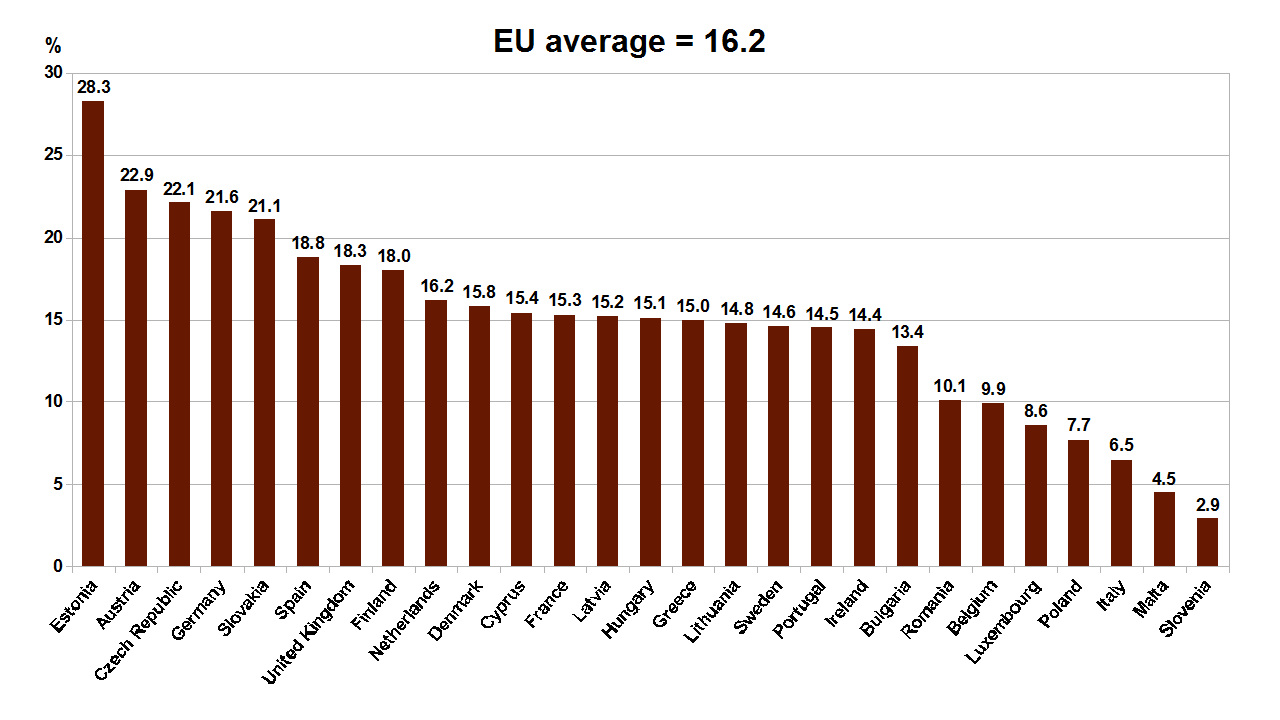 Bar graph showing the gender pay gap in European countries Gender pay gap in average gross hourly earnings according to Eurostat 2014[116] Studies have concluded that on average women earn lower wages than men worldwide. Some people argue that this results from widespread gender discrimination in the workplace. Others argue that the wage gap results from different choices by men and women, such as women placing more value than men on having children, and men being more likely than women to choose careers in high paying fields such as business, engineering, and technology. Eurostat found a persistent, average gender pay gap of 27.5% in the 27 EU member states in 2008.[116] Similarly, the OECD found that female full-time employees earned 27% less than their male counterparts in OECD countries in 2009.[101][102] In the United States, the female-to-male earnings ratio was 0.77 in 2009; female full-time, year-round (FTYR) workers earned 77% as much as male FTYR workers. Women's earnings relative to men's fell from 1960 to 1980 (56.7–54.2%), rose rapidly from 1980 to 1990 (54.2–67.6%), leveled off from 1990 to 2000 (67.6–71.2%) and rose from 2000 to 2009 (71.2–77.0%).[117][118] As of the late 2010s, it has decreased back to around 1990 to 2000 levels (68.6-71.1%).[119][120] When the first Equal Pay Act was passed in 1963, female full-time workers earned 48.9% as much as male full-time workers.[117] Research conducted in Czechia and Slovakia shows that, even after the governments passed anti-discrimination legislation, two thirds of the gender gap in wages remained unexplained and segregation continued to "represent a major source of the gap".[121] The gender gap can also vary across-occupation and within occupation. In Taiwan, for example, studies show how the bulk of gender wage discrepancies occur within-occupation.[122] In Russia, research shows that the gender wage gap is distributed unevenly across income levels, and that it mainly occurs at the lower end of income distribution.[123] The research also found that "wage arrears and payment in-kind attenuated wage discrimination, particularly amongst the lowest paid workers, suggesting that Russian enterprise managers assigned lowest importance to equity considerations when allocating these forms of payment".[123] The gender pay gap has been attributed to differences in personal and workplace characteristics between men and women (such as education, hours worked and occupation), innate behavioral and biological differences between men and women and discrimination in the labor market (such as gender stereotypes and customer and employer bias). Women take significantly more time off to raise children than men.[124] In certain countries such as South Korea, it has also been a long-established practice to lay-off female employees upon marriage.[125] A study by Professor Linda C. Babcock in her book Women Don't Ask shows that men are eight times more likely to ask for a pay raise, suggesting that pay inequality may be partly a result of behavioral differences between the sexes.[126] However, studies generally find that a portion of the gender pay gap remains unexplained after accounting for factors assumed to influence earnings; the unexplained portion of the wage gap is attributed to gender discrimination.[127] Estimates of the discriminatory component of the gender pay gap vary. The OECD estimated that approximately 30% of the gender pay gap across OECD countries is because of discrimination.[101] Australian research shows that discrimination accounts for approximately 60% of the wage differential between men and women.[128][129] Studies examining the gender pay gap in the United States show that a much of the wage differential remains unexplained, after controlling for factors affecting pay. One study of college graduates found that the portion of the pay gap unexplained after all other factors are taken into account is five percent one year after graduating and 12% a decade after graduation.[130][131][132][133] A study by the American Association of University Women found that women graduates in the United States are paid less than men doing the same work and majoring in the same field.[134] 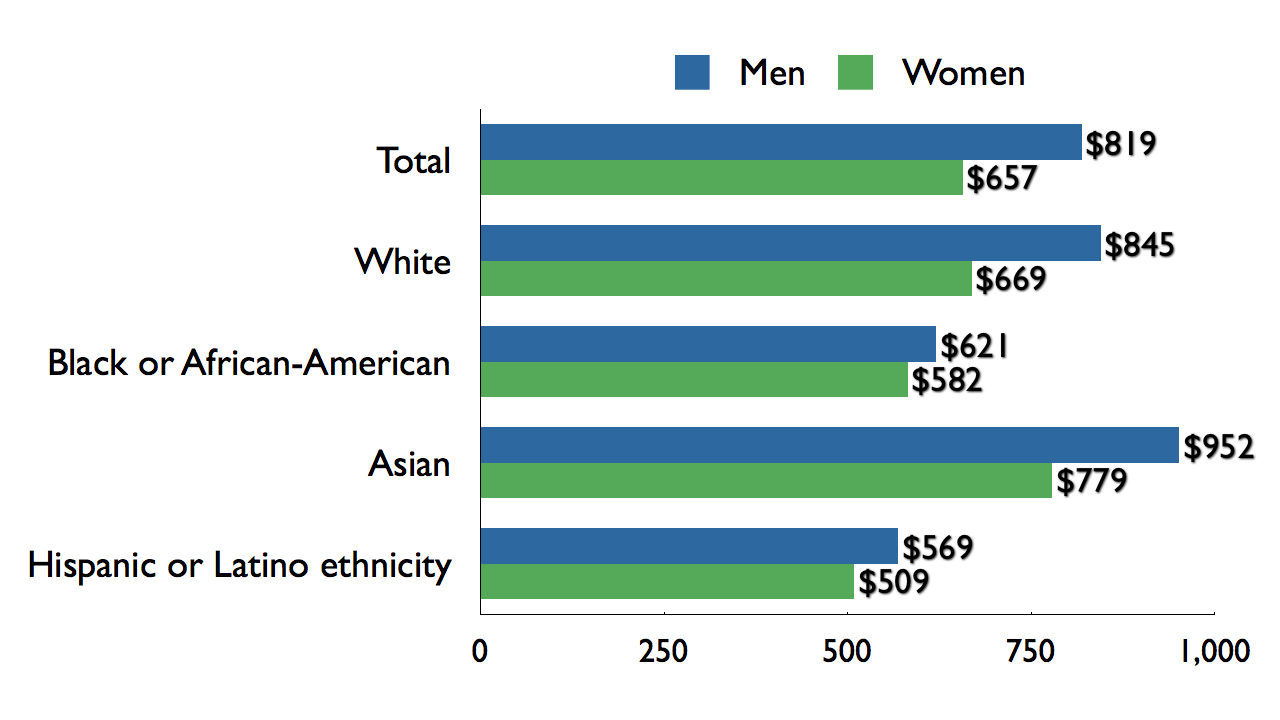 Graph showing weekly earnings by various categories Median weekly earnings of full-time wage and salary workers, by sex, race, and ethnicity, U.S., 2009[135] Wage discrimination is theorized as contradicting the economic concept of supply and demand, which states that if a good or service (in this case, labor) is in demand and has value it will find its price in the market. If a worker offered equal value for less pay, supply and demand would indicate a greater demand for lower-paid workers. If a business hired lower-wage workers for the same work, it would lower its costs and enjoy a competitive advantage. According to supply and demand, if women offered equal value demand (and wages) should rise since they offer a better price (lower wages) for their service than men do.[136] Research at Cornell University and elsewhere indicates that mothers in the United States are less likely to be hired than equally qualified fathers and, if hired, receive a lower salary than male applicants with children.[107][108][137][138][109][110] The OECD found that "a significant impact of children on women's pay is generally found in the United Kingdom and the United States".[139] Fathers earn $7,500 more, on average, than men without children do.[140] There is research to suggest that the gender wage gap leads to big losses for the economy.[141] Causes for wage discrimination The non-adjusted gender pay gap (the difference without taking into account differences in working hours, occupations, education, and work experience) is not itself a measure of discrimination. Rather, it combines differences in the average pay of women and men to serve as a barometer of comparison. Differences in pay are caused by: occupational segregation (with more men in higher paid industries and women in lower paid industries), vertical segregation (fewer women in senior, and hence better paying positions), ineffective equal pay legislation, women's overall paid working hours, and barriers to entry into the labor market (such as education level and single parenting rate).[142] Some variables that help explain the non-adjusted gender pay gap include economic activity, working time, and job tenure.[142] Gender-specific factors, including gender differences in qualifications and discrimination, overall wage structure, and the differences in remuneration across industry sectors all influence the gender pay gap.[143] Eurostat estimated in 2016 that after allowing for average characteristics of men and women, women still earn 11.5% less than men. Since this estimate accounts for average differences between men and women, it is an estimation of the unexplained gender pay gap (i.e., that which cannot be accounted for by factors such as differences in profession).[144] Glass ceiling effect Main article: Glass ceiling "The popular notion of glass ceiling effects implies that gender (or other) disadvantages are stronger at the top of the hierarchy than at lower levels and that these disadvantages become worse later in a person's career."[145] In the United States, women account for 52% of the overall labor force, but make up only three percent of corporate CEOs and top executives.[146] Some researchers see the root cause of this situation in the tacit discrimination based on gender, conducted by current top executives and corporate directors (primarily male), and "the historic absence of women in top positions", which "may lead to hysteresis, preventing women from accessing powerful, male-dominated professional networks, or same-sex mentors".[146] The glass ceiling effect is noted as being especially persistent for women of color. According to a report, "women of colour perceive a 'concrete ceiling' and not simply a glass ceiling".[146] In the economics profession, it has been observed that women are more inclined than men to dedicate their time to teaching and service. Since continuous research work is crucial for promotion, "the cumulative effect of small, contemporaneous differences in research orientation could generate the observed significant gender difference in promotion".[147] In the high-tech industry, research shows that, regardless of the intra-firm changes, "extra-organizational pressures will likely contribute to continued gender stratification as firms upgrade, leading to the potential masculinization of skilled high-tech work".[148] The United Nations asserts that "progress in bringing women into leadership and decision making positions around the world remains far too slow".[149] Potential remedies Research by David Matsa and Amalia Miller suggests that a remedy to the glass ceiling could be increasing the number of women on corporate boards, which could lead to increases in the number of women working in top management positions.[146] The same research suggests that this could also result in a "feedback cycle in which the presence of more female managers increases the qualified pool of potential female board members (for the companies they manage, as well as other companies), leading to greater female board membership and then further increases in female executives".[149] Weight-based sexism A 2009 study found that being overweight harms women's career advancement, but presents no barrier for men. Overweight women were significantly underrepresented among company bosses, making up between five and 22% of female CEOs. However, the proportion of overweight male CEOs was between 45% and 61%, over-representing overweight men. On the other hand, approximately five percent of CEOs were obese among both genders. The author of the study stated that the results suggest that "the 'glass ceiling effect' on women's advancement may reflect not only general negative stereotypes about the competencies of women but also weight bias that results in the application of stricter appearance standards to women."[150][151] Transgender discrimination See also: Transgender inequality Transgender people also experience significant workplace discrimination and harassment.[152] Unlike sex-based discrimination, refusing to hire (or firing) a worker for their gender identity or expression is not explicitly illegal in most U.S. states.[153] In June 2020, the United States Supreme Court ruled that federal civil rights law protects gay, lesbian and transgender workers. Writing for the majority, Justice Neil Gorsuch wrote: "An employer who fires an individual for being homosexual or transgender fires that person for traits or actions it would not have questioned in members of a different sex. Sex plays a necessary and undisguisable role in the decision, exactly what Title VII forbids."[154] The ruling however did not protect LGBT employees from being fired based on their sexual orientation or gender identity in businesses of 15 workers or less.[155] In August 1995, Kimberly Nixon filed a complaint with the British Columbia Human Rights Tribunal against Vancouver Rape Relief & Women's Shelter. Nixon, a trans woman, had been interested in volunteering as a counsellor with the shelter. When the shelter learned that she was transsexual, they told Nixon that she would not be allowed to volunteer with the organization. Nixon argued that this constituted illegal discrimination under Section 41 of the British Columbia Human Rights Code. Vancouver Rape Relief countered that individuals are shaped by the socialization and experiences of their formative years, and that Nixon had been socialized as a male growing up, and that, therefore, Nixon would not be able to provide sufficiently effective counselling to the female born women that the shelter served. Nixon took her case to the Supreme Court of Canada, which refused to hear the case.[156] |
職業差別 詳細は「職業差別」および「第二世代のジェンダーバイアス」を参照 「看護師をファーストネームで呼ぶ」 女性が大半を占める職業に就く個人に対して、ファーストネームで呼ぶという慣習は医療現場でも見られる。医師は通常、苗字で呼ばれるが、看護師は、たとえ 面識のない医師であっても、ファーストネームで呼ばれる。スザンヌ・ゴードンによると、医師と看護師の典型的な会話は次の通りである。「やあ、ジェーン。 私はスミス医師だ。患者のカルテを取ってくれないか?」 看護の逆境:医療費削減、メディアのステレオタイプ、医療の傲慢が看護師と患者ケアを蝕む[100] 職業上の性差別とは、職場において、個人の性別を理由とした差別的な慣行、発言、行動を指す。職業上の性差別の1つの形態は賃金差別である。2008年、 経済協力開発機構(OECD)は、女性の就業率が拡大し、男女間の就業および賃金格差がほぼすべての国で縮小している一方で、平均すると女性は依然として 男性よりも20%低い就業率と17%低い賃金しか得られていないことを明らかにした。[101] 報告書には次のように記載されている。 多くの国々では、労働市場における差別、すなわち、特定のグループに属しているという理由だけで、生産性は同等であるにもかかわらず不平等な扱いを受ける ことが、依然として雇用と雇用機会の質における格差を拡大させる重要な要因となっている。...本稿で提示された証拠は、 雇用見通し』の最新版で提示された証拠によると、OECD諸国における男女間の雇用格差の8パーセント、男女間の賃金格差の30パーセントは、労働市場に おける差別的慣行によって説明できるという。[101][102] また、米国を含むほぼすべてのOECD諸国が反差別法を制定しているにもかかわらず、これらの法律の施行は困難であることも判明した。[101] 男性が大半を占める職場グループに入った女性は、形ばかりの政策による悪影響を被る可能性がある。すなわち、パフォーマンスに対するプレッシャー、社会的 孤立、役割の固定化などである。形ばかりの政策は、性差別を隠ぺいし、職場における男性労働者の優位性を維持するために利用される可能性がある。組織や企 業で働く女性の割合と、労働条件の改善との間に関連性は見られない。性差別的な問題を無視することは、女性の職業上の問題を悪化させる可能性がある。 2005年の世界価値観調査では、回答者に賃金労働を男性のみに制限すべきかどうかを尋ねた。アイスランドでは、これに賛成する回答者の割合は3.6%で あったのに対し、エジプトでは94.9%であった。[106] 雇用における格差 米国では、母親は同等資格の父親よりも採用される可能性が低く、採用された場合でも、子供を持つ男性応募者よりも給与が低いという研究結果が繰り返し示さ れている。[107][108][109][110] ある研究では、女性応募者が有利であるという結果が出たが、この結果は、この問題に関する他のほとんどの研究結果と矛盾しているため、他の研究者からは懐 疑的に見られている。カリフォルニア大学ヘイスティングス法科大学院のジョアン・C・ウィリアムズ特別教授は、その方法論に問題があると指摘し、その研究 で用いられた架空の女性候補者は異常に高い資格を有していると指摘した。より現実的な資格を有する大学院生を対象とした研究では、男性学生の方がはるかに 高い確率で採用され、より高い給与が提示され、指導役が提供されることが分かっている。 ヨーロッパでは、労働市場におけるフィールド実験に基づく研究により、女性であることを理由とした深刻なレベルの差別は存在しないという証拠が示されてい る。しかし、特定の状況下では依然として不平等な扱いが測定されており、例えばベルギーではより高い職位の職に就くために応募する場合[113]、フラン スでは出産適齢期に申し込む場合[114]、オーストリアでは男性優位の職業に申し込む場合[115]などである。 収入格差 詳細は「男女間賃金格差」を参照  欧州諸国の男女間賃金格差を示す棒グラフ ユーロスタットによる2014年の平均総時間給における男女間賃金格差[116] 研究では、世界的に見て、平均して女性は男性よりも低い賃金しか得ていないという結論が出ている。この結果は職場における広範な性差別によるものだという 主張もある。また、賃金格差は、女性が男性よりも子供を持つことを重視する傾向にあることや、男性が女性よりもビジネス、エンジニアリング、テクノロジー などの高賃金の分野でのキャリアを選ぶ傾向にあることなど、男女の異なる選択によるものだという主張もある。 欧州統計局(Eurostat)は、2008年のEU加盟27カ国において、根強く残る平均的な男女賃金格差は27.5%であることを発見した。 [116] 同様に、OECDは2009年のOECD諸国において、女性フルタイム従業員の賃金は男性の同僚よりも27%低いことを発見した。[101][102] 米国では、2009年の女性と男性の収入比は0.77であり、フルタイムで年間を通じて働く女性(FTYR)の収入は、男性のFTYR労働者の77%で あった。男性に対する女性の収入比率は、1960年から1980年にかけては減少(56.7–54.2%)したが、1980年から1990年にかけては急 速に上昇(54.2–67.6%)し、1990年から2000年にかけては横ばい(67.6–71.2%)となり、 2000年から2009年にかけて上昇した(71.2–77.0%)。[117][118] 2010年代後半の時点で、1990年から2000年頃の水準(68.6-71.1%)まで減少している 1990年から2000年頃の水準(68.6~71.1%)に戻っている。[119][120] 1963年に初の男女同一賃金法が可決された際、女性のフルタイム労働者の賃金は男性のフルタイム労働者の48.9%であった。[117] チェコとスロバキアで行われた調査によると、政府が反差別法を制定した後でも、賃金における男女格差の3分の2は説明がつかず、分離は「格差の主な原因」 であり続けた。 また、性別による賃金格差は職種によっても異なる。例えば台湾では、賃金格差の大部分が同一職種内で発生していることが研究で示されている。[122] ロシアでは、賃金格差が収入レベルによって不均等に分布しており、主に収入分布の下位で発生していることが研究で示されている。[ 123] また、この調査では、「賃金の延滞や現物支給は賃金差別を弱めるが、特に最低賃金の労働者においてその傾向が強い。これは、ロシアの企業経営者が、これら の形態の支払いを割り当てる際に、公平性の考慮を最も重要視していないことを示唆している」ことも判明した。[123] 男女間の賃金格差は、男女間の個人的および職場における特性(教育、就業時間、職業など)の相違、男女間の生来の行動および生物学的相違、労働市場におけ る差別(性別による固定観念や顧客および雇用主の偏見など)に起因している。女性は男性よりも育児のために休む時間がはるかに長い。[124] 韓国などの特定の国では、結婚を機に女性従業員を解雇するという慣行も長年続いてきた。[125] リンダ・C・バブコック教授の著書『Women Don't Ask』に掲載された研究によると、男性は 昇給を求める傾向が強いことを示しており、賃金格差は男女の行動の違いが原因である可能性があることを示唆している。[126] しかし、一般的に、収入に影響を与えると想定される要因を考慮しても、男女間の賃金格差の一部は説明できないことが研究により判明している。賃金格差の説 明できない部分は、性差別によるものとされている。[127] 男女間賃金格差における差別的要素の推定値は様々である。OECDは、OECD諸国における男女間賃金格差の約30%は差別によるものと推定している。 [101] オーストラリアの研究では、賃金格差の約60%が差別によるものとされている。[128][129] 米国における男女間賃金格差を調査した研究では、賃金に影響を与える要因を考慮した後でも、賃金格差の大部分は説明できないままであることが示されてい る。ある大学卒業生を対象とした研究では、他の要因をすべて考慮しても説明できない賃金格差の割合は、卒業後1年で5%、卒業後10年で12%であること が分かった。[130][131][132][133] アメリカ大学女性協会による研究では、米国では女性卒業生の賃金は、同じ仕事で同じ専攻分野の男性卒業生よりも低いことが分かった。[134]  さまざまなカテゴリー別の週収を示すグラフ 性別、人種、民族別のフルタイム賃金・給与労働者の中央値週収、米国、2009年[135] 賃金差別は、需要と供給の経済理論に反するものとされている。需要があり価値がある商品やサービス(この場合、労働)は市場で価格が決まるという理論であ る。労働者が同等の価値を提供しながら賃金を下げれば、需要と供給の観点では低賃金の労働者に対する需要が高まることになる。企業が同じ仕事に対して低賃 金の労働者を雇えば、コストが削減され、競争優位性も得られる。需要と供給の観点では、女性が同等の価値を提供すれば需要(および賃金)は上昇するはずで ある。なぜなら、女性は男性よりもサービスに対してより低い賃金(低賃金)を提示しているからだ。 コーネル大学やその他の研究機関の調査によると、米国では母親は同等資格の父親よりも採用される可能性が低く、採用されたとしても、子供がいる男性応募者 よりも低い給与しか受け取っていないことが示されている。[107][108][137][138][109][1 10] OECDは、「女性の賃金に対する子供の影響は、一般的に英国と米国で顕著である」と結論づけている。[139] 父親は、子供を持たない男性よりも平均で7,500ドル多く稼いでいる。[140] 賃金格差が経済に大きな損失をもたらすことを示す研究結果がある。[141] 賃金差別の原因 調整されていない男女賃金格差(労働時間、職業、教育、職歴の違いを考慮しない場合の差異)は、それ自体は差別を意味するものではない。むしろ、これは男 女の平均賃金の差異を組み合わせたものであり、比較のバロメーターとして用いられる。賃金の差異は、以下のような要因によって生じる。 職業分離(賃金が高い産業に男性が多く、賃金の低い産業に女性が多い)、 垂直分離(上級職に就く女性が少ないため、賃金も高くない)、 平等な賃金に関する法律の非効率性、 女性の総労働時間、 労働市場参入の障壁(学歴や片親家庭の割合など)[142] 調整されていない男女間賃金格差を説明するのに役立つ変数には、経済活動、労働時間、および勤続年数などがある。[142] 性別による要因、すなわち資格や差別における性差、賃金体系全体、および産業部門間の報酬の違いはすべて、男女間賃金格差に影響を及ぼす。[143] 欧州統計局(ユーロスタット)は2016年に、男女の平均的な特性を考慮した後でも、女性の賃金は男性よりも11.5%低いと推定した。この推定値は男女 間の平均的な差異を考慮したものであるため、説明できない男女間の賃金格差(すなわち、職業の違いなどの要因では説明できないもの)の推定値である。 [144] ガラスの天井効果 詳細は「ガラスの天井」を参照 「一般的に考えられているガラスの天井効果とは、性別(またはその他の)による不利益は、階層の下層部よりも上層部でより強く、また、これらの不利益は、 個人のキャリアの後期になるほど悪化するということを意味している」[145] 米国では、女性は労働力の52%を占めているが、企業のCEOや経営陣では3%に過ぎない。[146] 研究者の中には、この状況の根本的原因は、現在の経営陣や企業役員(主に男性)による性別に基づく暗黙の差別と、 主に男性である)現職の経営陣や企業役員による性別に基づく暗黙の差別、および「歴史的に女性がトップの地位に就いてこなかったこと」が原因であり、これ が「ヒステリシスにつながり、女性が男性優位の強力な職業ネットワークや同性の上司にアクセスできない可能性がある」と指摘する研究者もいる。[146] ガラスの天井効果は、有色人種の女性にとって特に根強いと指摘されている。ある報告書によると、「有色人種の女性は、単なるガラスの天井ではなく、『具体 的な天井』を認識している」という。[146] 経済学の分野では、女性は男性よりも教育や奉仕に時間を割く傾向が強いことが観察されている。昇進には継続的な研究活動が不可欠であるため、「研究志向に おける同時的な小さな差異の累積的効果によって、観察されたような著しい性差が昇進に生じる可能性がある」のである。[147] ハイテク産業では、企業内の変化とは関係なく、「企業がアップグレードするにつれ、組織外からの圧力が継続的な性別による階層化に寄与し、熟練したハイテ ク作業の潜在的な男性化につながる可能性が高い」という調査結果が出ている。[148] 国連は、「世界中で女性を指導的立場や意思決定のポジションに就かせるという点において、進歩は依然としてあまりにも遅々としている」と主張している。 [149] 潜在的な解決策 デビッド・マツァとアマリア・ミラーによる研究では、ガラスの天井を打ち破る解決策として、企業取締役会における女性の数を増やすことが挙げられており、 それにより、最高経営責任者のポジションに就く女性の数も増加する可能性があるとしている。[146] 同じ研究では、このことが 「女性管理職の増加が、女性取締役候補者の母集団を(彼女らが管理する企業だけでなく、他の企業も含めて)増大させ、結果として女性取締役の増加につなが り、さらに女性管理職の増加につながる」というフィードバック・サイクルが生まれる可能性があることを示唆している。[149] 体重に基づく性差別 2009年の研究では、太り過ぎは女性のキャリアアップを妨げるが、男性には何の障害にもならないことが分かった。太り過ぎの女性は、会社の経営陣に著し く過小に代表されており、女性CEOの5~22%を占めるに過ぎない。しかし、太り過ぎの男性CEOの割合は45~61%であり、太り過ぎの男性が過剰に 代表されている。一方、男女ともに約5%のCEOが肥満であった。この研究の著者は、この結果は「女性の昇進に対する『ガラスの天井効果』が、女性の能力 に対する一般的な否定的な固定観念だけでなく、女性に対してより厳しい外見基準が適用される結果となる体重に対する偏見を反映している可能性がある」こと を示唆していると述べた。[150][151] トランスジェンダーに対する差別 関連項目:トランスジェンダーに対する不平等 トランスジェンダーの人々も、職場において重大な差別や嫌がらせを経験している。[152] 性別に基づく差別とは異なり、性自認や性表現を理由に労働者を雇用しない(または解雇する)ことは、ほとんどの米国の州では明確に違法とはされていない。 [153] 2020年6月、米国最高裁判所は、連邦公民権法が同性愛者、レズビアン、トランスジェンダーの労働者を保護しているとの判決を下した。多数派を代表し て、ニール・ゴーサッチ判事は次のように述べた。「同性愛者またはトランスジェンダーであることを理由に解雇する雇用主は、異性愛者に対しては疑問を持た ないであろうその人物の特徴や行動を理由に解雇している。性別は、その決定において必要かつ隠しようのない役割を果たしており、まさに第7条が禁じている ことである」[154] しかし、この判決は、従業員15人以下の企業において、性的指向や性自認を理由に解雇されるLGBT従業員を保護するものではなかった。[155] 1995年8月、キンバリー・ニクソンはブリティッシュコロンビア人権法廷に、バンクーバー・レイプ・リリーフ・アンド・ウィメンズ・シェルターに対する 苦情を申し立てた。トランスジェンダーの女性であるニクソンは、シェルターのカウンセラーとしてボランティア活動に興味を持っていた。シェルター側が彼女 がトランスセクシュアルであることを知ると、ニクソンにボランティア活動は許可できないと告げた。ニクソンは、これはブリティッシュコロンビア人権法第 41条に違反する違法な差別であると主張した。バンクーバー・レイプ・リリーフは、個人はその形成期の社会化や経験によって形作られるものであり、ニクソ ンは男性として成長してきたため、シェルターが支援する女性に対して十分な効果的なカウンセリングを提供できないと反論した。ニクソンはカナダ最高裁判所 に訴えたが、最高裁は審理を拒否した。[156] |
Objectification Illustration of a woman splayed across a wine menu Example of sexual objectification of women on a wine menu In social philosophy, objectification is the act of treating a person as an object or thing. Objectification plays a central role in feminist theory, especially sexual objectification.[157] Feminist writer and gender equality activist Joy Goh-Mah argues that by being objectified, a person is denied agency.[158] According to the philosopher Martha Nussbaum, a person might be objectified if one or more of the following properties are applied to them:[159] Instrumentality: treating the object as a tool for another's purposes: "The objectifier treats the object as a tool of his or her purposes." Denial of autonomy: treating the object as lacking in autonomy or self-determination: "The objectifier treats the object as lacking in autonomy and self-determination." Inertness: treating the object as lacking in agency or activity: "The objectifier treats the object as lacking in agency, and perhaps also in activity." Fungibility: treating the object as interchangeable with other objects: "The objectifier treats the object as interchangeable (a) with other objects of the same type, and/or (b) with objects of other types." Violability: treating the object as lacking in boundary integrity and violable: "The objectifier treats the object as lacking in boundary integrity, as something that it is permissible to break up, smash, break into." Ownership: treating the object as if it can be owned, bought, or sold: "The objectifier treats the object as something that is owned by another, can be bought or sold, etc." Denial of subjectivity: treating the object as if there is no need for concern for its experiences or feelings: "The objectifier treats the object as something whose experience and feelings (if any) need not be taken into account." Rae Helen Langton, in Sexual Solipsism: Philosophical Essays on Pornography and Objectification, proposed three more properties to be added to Nussbaum's list:[157][160] Reduction to Body: the treatment of a person as identified with their body, or body parts; Reduction to Appearance: the treatment of a person primarily in terms of how they look, or how they appear to the senses; Silencing: the treatment of a person as if they are silent, lacking the capacity to speak. According to objectification theory, objectification can have important repercussions on women, particularly young women, as it can negatively impact their psychological health and lead to the development of mental disorders, such as unipolar depression, sexual dysfunction, and eating disorders.[161] In advertising  Two girls examining a bulletin board posted on a fence. An advertisement painted above them asks "Are You a Woman?". Women examining a bulletin board posted on a fence. An advertisement painted above them asks "Are You a Woman?" While advertising used to portray women and men in obviously stereotypical roles (e.g., as a housewife, breadwinner), in modern advertisements, they are no longer solely confined to their traditional roles. However, advertising today still stereotypes men and women, albeit in more subtle ways, including by sexually objectifying them.[162] Women are most often targets of sexism in advertising.[citation needed] When in advertisements with men they are often shorter and put in the background of images, shown in more "feminine" poses, and generally present a higher degree of "body display".[163] Today, some countries (for example Norway and Denmark) have laws against sexual objectification in advertising.[164] Nudity is not banned, and nude people can be used to advertise a product if they are relevant to the product advertised. Sol Olving, head of Norway's Kreativt Forum (an association of the country's top advertising agencies) explained, "You could have a naked person advertising shower gel or a cream, but not a woman in a bikini draped across a car".[164] Other countries continue to ban nudity (on traditional obscenity grounds), but also make explicit reference to sexual objectification, such as Israel's ban of billboards that "depicts sexual humiliation or abasement, or presents a human being as an object available for sexual use".[165] Pornography See also: Feminist views on pornography Anti-pornography feminist Catharine MacKinnon argues that pornography contributes to sexism by objectifying women and portraying them in submissive roles.[166] MacKinnon, along with Andrea Dworkin, argues that pornography reduces women to mere tools, and is a form of sex discrimination.[167] The two scholars highlight the link between objectification and pornography by stating: We define pornography as the graphic sexually explicit subordination of women through pictures and words that also includes (i) women are presented dehumanized as sexual objects, things, or commodities; or (ii) women are presented as sexual objects who enjoy humiliation or pain; or (iii) women are presented as sexual objects experiencing sexual pleasure in rape, incest or other sexual assault; or (iv) women are presented as sexual objects tied up, cut up or mutilated or bruised or physically hurt; or (v) women are presented in postures or positions of sexual submission, servility, or display; or (vi) women's body parts—including but not limited to vaginas, breasts, or buttocks—are exhibited such that women are reduced to those parts; or (vii) women are presented being penetrated by objects or animals; or (viii) women are presented in scenarios of degradation, humiliation, injury, torture, shown as filthy or inferior, bleeding, bruised, or hurt in a context that makes these conditions sexual."[168] Robin Morgan and Catharine MacKinnon suggest that certain types of pornography also contribute to violence against women by eroticizing scenes in which women are dominated, coerced, humiliated or sexually assaulted.[169][170] Some people opposed to pornography, including MacKinnon, charge that the production of pornography entails physical, psychological, and economic coercion of the women who perform and model in it.[171][172][173] Opponents of pornography charge that it presents a distorted image of sexual relations and reinforces sexual myths; it shows women as continually available and willing to engage in sex at any time, with any person, on their terms, responding positively to any requests. MacKinnon writes: Pornography affects people's belief in rape myths. So for example if a woman says "I didn't consent" and people have been viewing pornography, they believe rape myths and believe the woman did consent no matter what she said. That when she said no, she meant yes. When she said she didn't want to, that meant more beer. When she said she would prefer to go home, that means she's a lesbian who needs to be given a good corrective experience. Pornography promotes these rape myths and desensitizes people to violence against women so that you need more violence to become sexually aroused if you're a pornography consumer. This is very well documented.[174] Defenders of pornography and anti-censorship activists (including sex-positive feminists) argue that pornography does not seriously impact a mentally healthy individual, since the viewer can distinguish between fantasy and reality.[175] Some also contend that both men and women are objectified in pornography, particularly sadistic or masochistic pornography in which men are objectified and sexually used by women.[176] Prostitution Prostitution is the business or practice of engaging in sexual relations for payment.[177][178] Sex workers are often objectified and are seen as existing only to serve clients, thus calling their sense of agency into question. There is a prevailing notion that because they sell sex professionally, prostitutes automatically consent to all sexual contact.[179] As a result, sex workers face higher rates of violence and sexual assault. This is often dismissed, ignored and not taken seriously by authorities.[179] In many countries, prostitution is dominated by brothels or pimps, who often claim ownership over sex workers. This sense of ownership furthers the concept that sex workers are void of agency.[180] This is literally the case in instances of sexual slavery. Various authors have argued that female prostitution is based on male sexism that condones the idea that unwanted sex with a woman is acceptable, that men's desires must be satisfied, and that women are coerced into and exist to serve men sexually.[181][182][183][184] The European Women's Lobby condemned prostitution as "an intolerable form of male violence".[185] Carole Pateman writes that: Prostitution is the use of a woman's body by a man for his own satisfaction. There is no desire or satisfaction on the part of the prostitute. Prostitution is not mutual, pleasurable exchange of the use of bodies, but the unilateral use of a woman's body by a man in exchange for money.[186] Media portrayals See also: Misogyny in rap music and Sexism in heavy metal music Some scholars believe that media portrayals of demographic groups can both maintain and disrupt attitudes and behaviors toward those groups.[187][page needed][188][189][page needed] According to Susan Douglas: "Since the early 1990s, much of the media have come to overrepresent women as having made it-completely-in the professions, as having gained sexual equality with men, and having achieved a level of financial success and comfort enjoyed primarily by Tiffany's-encrusted doyennes of Laguna Beach."[190] These images may be harmful, particularly to women and racial and ethnic minority groups. For example, a study of African American women found they feel that media portrayals of themselves often reinforce stereotypes of this group as overly sexual and idealize images of lighter-skinned, thinner African American women (images African American women describe as objectifying).[191] In a recent analysis of images of Haitian women in the Associated Press photo archive from 1994 to 2009, several themes emerged emphasizing the "otherness" of Haitian women and characterizing them as victims in need of rescue.[192] In an attempt to study the effect of media consumption on males, Samantha and Bridges found an effect on body shame, though not through self-objectification as it was found in comparable studies of women. The authors conclude that the current measures of objectification were designed for women and do not measure men accurately.[193] Another study found a negative effect on eating attitudes and body satisfaction of consumption of beauty and fitness magazines for women and men respectively but again with different mechanisms, namely self-objectification for women and internalization for men.[194] Sexist jokes Frederick Attenborough argues that sexist jokes can be a form of sexual objectification, which reduce the butt of the joke to an object. They not only objectify women, but can also condone violence or prejudice against women.[195] "Sexist humor—the denigration of women through humor—for instance, trivializes sex discrimination under the veil of benign amusement, thus precluding challenges or opposition that nonhumorous sexist communication would likely incur."[196] A study of 73 male undergraduate students by Ford found that "sexist humor can promote the behavioral expression of prejudice against women amongst sexist men".[196] According to the study, when sexism is presented in a humorous manner it is viewed as tolerable and socially acceptable: "Disparagement of women through humor 'freed' sexist participants from having to conform to the more general and more restrictive norms regarding discrimination against women."[196] |
客体化 ワインメニューに広げられた女性のイラスト ワインメニューにおける女性の性的客体化の例 社会哲学において、客体化とは、ある人物を物や対象として扱う行為である。客体化はフェミニズム理論、特に性的客体化において中心的な役割を果たしてい る。[157] フェミニスト作家であり男女平等活動家のジョイ・ゴー・マーは、客体化されることで、人は主体性を否定されると主張している。[158] 哲学者マーサ・ヌスバウムによると、人は以下の性質のうち一つ以上が当てはまる場合に客体化される可能性がある。[159] 道具化:対象を他者の目的のための道具として扱うこと:「対象化する者は対象を自身の目的のための道具として扱う。 」 不活性:対象を主体性や活動性のないものとして扱うこと:「対象化する者は対象を主体性のないものとして扱い、おそらくは活動性のないものとしても扱う。 代替可能性:対象を他の対象と交換可能であるかのように扱う:「対象化する者は対象を、(a) 同じタイプの他の対象、および/または (b) 他のタイプの対象と交換可能であるかのように扱う。 侵害可能性:対象を境界の完全性を欠き、侵害可能であるかのように扱う:「対象化する者は対象を、境界の完全性を欠き、分割、粉砕、侵入することが許され るものであるかのように扱う。 所有:所有、購入、販売が可能であるかのように対象を扱う:「対象化する者は、対象を他者が所有しているもの、購入または販売が可能であるものなどとして 扱う」 主観性の否定:対象の経験や感情を気にかける必要がないかのように扱う:「対象化する者は、対象を、その経験や感情(もしあれば)を考慮する必要がないも のとして扱う」 レイ・ヘレン・ラングトンは著書『性的自己同一論:ポルノグラフィーと物化に関する哲学的エッセイ』の中で、ヌスバウムのリストにさらに3つの特性を追加 することを提案している。[157][160] 身体への還元:身体または身体の一部と同一視して個人を扱うこと。 外見への還元:主に外見や感覚に映る姿によって個人を扱うこと。 沈黙:あたかもその人が沈黙しているかのように、話す能力がないかのように扱うこと。 物象化理論によると、物象化は特に若い女性にとって重要な影響を及ぼす可能性がある。なぜなら、物象化は彼女たちの心理的健康に悪影響を及ぼし、単極性う つ病、性的機能障害、摂食障害などの精神障害を引き起こす可能性があるからである。[161] 広告では  フェンスに貼られた掲示板を調べる2人の少女。彼女たちの頭上には「あなたは女性ですか?」という広告が描かれている。 フェンスに貼られた掲示板を調べる女性たち。彼女たちの頭上には「あなたは女性ですか?」という広告が描かれている。 かつての広告では、女性と男性は明らかにステレオタイプな役割(例えば、主婦や稼ぎ手など)で描かれていたが、現代の広告では、もはや彼らは伝統的な役割 だけに限定されることはない。しかし、現代の広告は、より微妙な方法ではあるが、男女をステレオタイプ化しており、性的対象として扱うこともある。 [162] 広告における性差別は、女性が最も標的とされることが多い。[要出典] 男性と一緒の広告では、女性は背が低く、画像の背景に置かれることが多く、より「女性的」なポーズで描かれ、一般的に「身体の露出」の度合いが高い。 [163] 今日、一部の国(例えばノルウェーやデンマーク)では、広告における性的対象化を禁止する法律がある。[164] ヌードは禁止されておらず、広告される商品に関連性があれば、裸の人物を商品の広告に使うことができる。ノルウェーの広告代理店協会である Kreativt Forumの代表であるソル・オルビング氏は、「シャワージェルやクリームの広告に裸の人物を使うことは可能だが、ビキニ姿の女性が車に横たわるような広 告は認められない」と説明している。[164] 他の国々では、従来からのわいせつ性という理由でヌードを禁止し続けているが、性的対象化についても明確に言及している。例えば、イスラエルでは「性的屈 辱や蔑視を描写したり、人間を性的利用可能な対象として表現したりする」広告看板を禁止している。[165] ポルノグラフィー 参照:ポルノグラフィーに対するフェミニストの見解 反ポルノグラフィーのフェミニストであるキャサリン・マッキノンは、ポルノグラフィーは女性を客体化し従順な役割として描くことで性差別を助長していると 主張している。[166] マッキノンはアンドレア・ドウォーキンとともに、ポルノグラフィーは女性を単なる道具に貶め、性差別の形態であると主張している。[167] 2人の学者は、客体化とポルノグラフィーの関連性を次のように強調している。 私たちは、ポルノグラフィーを、絵や言葉によって女性の従属を露骨に性的に表現したものと定義する。その表現には、(i) 女性が性的対象物、物、商品として人間性を奪われた形で表現されているもの、(ii) 女性が屈辱や苦痛を享受する性的対象物として表現されているもの、(iii) 女性がレイプ、近親相姦、その他の性的暴行の中で性的快楽を経験する性的対象物として表現されているもの、(iv) 女性が縛られたり、切り刻まれたり、身体を傷つけられたり、あざだらけになったり、肉体的に傷つけられたりする性的対象物として表現されているもの、 (v) 女性が性的服従、卑屈、または服従の姿勢や体勢で表現されているもの、が含まれる。性的暴行、または(iv)女性が性的対象物として縛られ、切り刻まれ、 または身体の一部が損傷を受け、あざができたり、身体的危害を受けているように描写されている、または(v)女性が性的服従、卑屈、または性的な見せ物の ような姿勢や体勢で描写されている、または(vi)女性の身体の一部(膣、乳房、臀部など)が 女性がそれらの部分に還元されるような形で展示されている。または(vii)女性が物体や動物に貫かれている様子が描写されている。または(viii)女 性が、屈辱、侮辱、傷害、拷問などのシナリオの中で、不潔または劣っているものとして、あるいは性的な文脈の中で出血、あざ、負傷などの状態として描かれ ている。」[168] ロビン・モーガンとキャサリン・マッキノンは、特定の種類のポルノグラフィーが、女性が支配されたり、強制されたり、屈辱を受けたり、性的暴行を受けたり する場面をエロティックに描くことで、女性に対する暴力の一因となっていると指摘している。[169][170] マッキノンを含むポルノグラフィーに反対する一部の人々は、ポルノグラフィーの制作は、出演する女性やモデルに対して身体的、心理的、経済的な強制を伴う と主張している。[171][172][173] ポルノグラフィーに反対する人々は、ポルノグラフィーは性的関係の歪んだイメージを提示し、性的な神話を強化していると主張している。ポルノグラフィー は、女性がいつでも、誰とでも、自分の都合に合わせて、あらゆる要求に前向きに応じる用意があるかのように描いている。 マッキノンは次のように書いている。 ポルノはレイプ神話に対する人々の信念に影響を与える。例えば、女性が「私は同意していなかった」と言った場合、人々がポルノを見ていたとしたら、レイプ 神話を信じ、女性が何を言おうと同意していたと信じてしまう。女性が「ノー」と言った場合、それは「イエス」を意味する。彼女が「嫌だ」と言ったのは 「もっとビールが飲みたい」という意味だ。彼女が「帰りたい」と言ったのは「レズビアンだから、良い矯正経験をさせなければならない」という意味だ。ポル ノはこうしたレイプ神話を助長し、女性に対する暴力に対する人々の感覚を鈍らせる。そのため、ポルノの視聴者は、性的興奮を得るためにより多くの暴力を必 要とするようになる。これは十分に立証されている。[174] ポルノ擁護派や反検閲活動家(性肯定派フェミニストを含む)は、ポルノは現実と空想を区別できる精神的に健康な個人には深刻な影響を与えないと主張してい る。[175] また、ポルノでは男女ともに客体化されるが、特にサディストやマゾヒスト向けのポルノでは、男性が客体化され、女性によって性的に利用されると主張する者 もいる。[176] 売春 売春とは、金銭と引き換えに性的関係を持つ商売または行為である。[177][178] セックスワーカーはしばしば客の所有物と見なされ、顧客に奉仕することのみを目的として存在しているとみなされるため、彼女たちの主体性は疑問視される。 セックスを職業として売っているため、売春婦は自動的にあらゆる性的接触に同意しているという考え方が一般的である。[179] その結果、セックスワーカーはより高い割合で暴力や性的暴行に直面している。これは当局によってしばしば無視され、軽視され、真剣に受け止められない。 多くの国々では、売春は売春宿や売春斡旋業者が支配しており、彼らはしばしば性労働者に対して所有権を主張する。この所有権の感覚は、性労働者は主体性が ないという概念をさらに助長する。これは文字通り、性的奴隷の事例に当てはまる。 さまざまな著者が、女性買春は、望まない女性との性行為は許されるという考えを容認する男性の性差別主義に基づいていると主張している。また、男性の欲望 は満たされなければならないし、女性は性的に男性に奉仕するために強制され、存在しているという主張もある。[181][182][183][184] ヨーロッパ女性ロビーは、売春を「耐え難い男性の暴力の形」として非難した。[185] キャロル・パトマンは次のように書いている。 売春とは、男性が自身の満足のために女性の身体を利用することである。売春婦の側には、欲望も満足もない。売春は、身体の相互利用による快楽の交換ではな く、男性が金銭と引き換えに女性の身体を一方的に利用することである。 メディアの描写 関連項目:ラップミュージックにおける女性嫌悪、ヘビーメタル音楽における性差別 一部の学者は、メディアが人口統計的集団を描写することは、その集団に対する態度や行動を維持することにも、破壊することにもなりうると考えている。 [187][要ページ番号][188][189][要ページ番号] スーザン・ダグラスによると、 「1990年代初頭以降、多くのメディアは、女性が完全に職業で成功し、男性と性的に平等になり、主にティファニーの宝石で飾られた『ラグナビーチのオバ さん』たちが享受するような経済的成功と快適さを達成したかのように描きすぎている」[190] このようなイメージは、特に女性や人種的・民族的少数派グループにとって有害である可能性がある。例えば、アフリカ系アメリカ人女性を対象とした研究で は、メディアが自分たちを性的すぎる存在として描き、肌の色が白く、痩せたアフリカ系アメリカ人女性のイメージを理想化していると感じていることが分かっ た(アフリカ系アメリカ人女性は、このイメージを「対象化」と表現している)。[191] 1994年から2009年までのAP通信の写真アーカイブに収められたハイチ人女性のイメージに関する最近の分析では、ハイチ人女性の「他者性」を強調 し、彼女たちを救済を必要とする犠牲者として特徴づけるいくつかのテーマが浮かび上がった。 男性におけるメディア消費の影響を研究しようとしたサマンサとブリッジズは、女性を対象とした同様の研究で発見されたような自己客体化ではないものの、身 体的な恥に対する影響を発見した。著者は、現在の自己客体化の測定方法は女性向けに考案されたものであり、男性を正確に測定するものではないと結論づけて いる。[193] 別の研究では、女性と男性がそれぞれ美容雑誌とフィットネス雑誌を購読することによる、食生活や体型に対する態度への負の影響が発見されたが、そのメカニ ズムは異なっていた。すなわち、女性の場合は自己客体化、男性の場合は内面化である。[194] 性差別的なジョーク フレデリック・アッテンボローは、性差別的なジョークは性的対象化の一形態であり、ジョークの対象を単なる物として扱うものであると主張している。性差別 的なジョークは女性を客体化するだけでなく、女性に対する暴力や偏見を容認する可能性もある。「性差別的なユーモア、つまりユーモアを通じて女性を侮辱す るようなものは、例えば、娯楽という名目で性差別を矮小化し、ユーモアのない性差別的なコミュニケーションが引き起こすであろう挑戦や反対を排除する。 [196] フォードによる男子大学生73人を対象とした研究では、「性差別的なユーモアは、性差別的な男性の間で女性に対する偏見の行動表現を助長する可能性があ る」ことが分かった。[196] この研究によると、性差別がユーモアを交えて表現されると、それは容認可能で社会的に許容されるものとして受け止められる。「ユーモアによる女性蔑視は、 性差別主義者である参加者を、女性差別に関するより一般的で制限的な規範に従う必要から『解放』した」[196]。 |
| Gender identity discrimination Gender discrimination is discrimination based on actual or perceived gender identity.[197][page needed] Gender identity is "the gender-related identity, appearance, or mannerisms or other gender-related characteristics of an individual, with or without regard to the individual's designated sex at birth".[197][page needed] Gender discrimination is theoretically different from sexism.[198][page needed] Whereas sexism is prejudice based on biological sex, gender discrimination specifically addresses discrimination towards gender identities, including third gender, genderqueer, and other non-binary identified people.[7] It is especially attributed to how people are treated in the workplace,[8] and banning discrimination on the basis of gender identity and expression has emerged as a subject of contention in the American legal system.[199] According to a recent report by the Congressional Research Service, "although the majority of federal courts to consider the issue have concluded that discrimination on the basis of gender identity is not sex discrimination, there have been several courts that have reached the opposite conclusion".[197] Hurst states that "[c]ourts often confuse sex, gender and sexual orientation, and confuse them in a way that results in denying the rights not only of gays and lesbians, but also of those who do not present themselves or act in a manner traditionally expected of their sex".[200] Oppositional sexism Oppositional sexism is a term coined by transfeminist author Julia Serano, who defined oppositional sexism as "the belief that male and female are rigid, mutually exclusive categories".[201] Oppositional sexism plays a vital role in a number of social norms, such as cisnormativity and heteronormativity. Oppositional sexism normalizes masculine expression in males and feminine expression in females while simultaneously demonizing femininity in males and masculinity in females. This concept plays a crucial role in supporting cissexism, the social norm that views cisgender people as both natural and privileged as opposed to transgender people.[202] The idea of having two, opposite genders is tied to sexuality through what gender theorist Judith Butler calls a "compulsory practice of heterosexuality".[202] Because oppositional sexism is tied to heteronormativity in this way, non-heterosexuals are seen as breaking gender norms.[202] The concept of opposite genders sets a "dangerous precedent", according to Serano, where "if men are big then women must be small; and if men are strong then women must be weak".[201] The gender binary and oppositional norms work together to support "traditional sexism", the belief that femininity is inferior to and serves masculinity.[202] Serano states that oppositional sexism works in tandem with "traditional sexism". This ensures that "those who are masculine have power over those who are feminine, and that only those that are born male will be seen as authentically masculine."[201] Transgender discrimination See also: Transphobia and Healthcare and the LGBT community Transgender discrimination is discrimination towards peoples whose gender identity differs from the social expectations of the biological sex they were born with.[203] Forms of discrimination include but are not limited to identity documents not reflecting one's gender, sex-segregated public restrooms and other facilities, dress codes according to binary gender codes, and lack of access to and existence of appropriate health care services.[204] In a recent adjudication, the Equal Employment Opportunity Commission (EEOC) concluded that discrimination against a transgender person is sex discrimination.[204] The 2008–09 National Transgender Discrimination Survey (NTDS)—a U.S. study by the National Center for Transgender Equality and the National Gay and Lesbian Task Force in collaboration with the National Black Justice Coalition that was, at its time, the most extensive survey of transgender discrimination—showed that Black transgender people in the United States suffer "the combination of anti-transgender bias and persistent, structural and individual racism" and that "black transgender people live in extreme poverty that is more than twice the rate for transgender people of all races (15%), four times the general Black population rate (9%) and over eight times the general US population rate (4%)".[205] Further discrimination is faced by gender nonconforming individuals, whether transitioning or not, because of displacement from societally acceptable gender binaries and visible stigmatization. According to the NTDS, transgender gender nonconforming (TGNC) individuals face between eight percent and 15% higher rates of self and social discrimination and violence than binary transgender individuals. Lisa R. Miller and Eric Anthony Grollman found in their 2015 study that "gender nonconformity may heighten trans people's exposure to discrimination and health-harming behaviors. Gender nonconforming trans adults reported more events of major and everyday transphobic discrimination than their gender conforming counterparts."[206] In another study conducted in collaboration with the League of United Latin American Citizens, Latino/a transgender people who were non-citizens were most vulnerable to harassment, abuse and violence.[207] An updated version of the NTDS survey, called the 2015 U.S. Transgender Survey, was published in December 2016.[208] |
性自認に基づく差別 性差別とは、実際の性自認または認識された性自認に基づく差別である。[197][要ページ番号] 性自認とは、「出生時に指定された性別を考慮した、または考慮しない、個人の性別に関するアイデンティティ、外見、または癖やその他の性別に関する特徴」 である。[197][要ページ番号] 性差別は理論的には性差別主義とは異なる。[198][要ページ番号] 性差別は生物学的な性に基づく偏見であるのに対し、ジェンダー差別は特に第3の性、ジェンダー・クィア、その他の非二元的なアイデンティティを持つ人々を 含むジェンダー・アイデンティティに対する差別を扱うものである。[7] 特に職場での待遇に起因するものであるとされ、[8] ジェンダー・アイデンティティやジェンダー表現に基づく差別を禁止することが、アメリカの法制度における論争の対象となっている。[199] 米国議会調査局の最近の報告書によると、「この問題を検討した連邦裁判所の大多数は、性自認に基づく差別は性差別ではないと結論づけているが、反対の結論 に達した裁判所もいくつかある」という。[197] ハースは次のように述べている。「 裁判所はしばしば性別、ジェンダー、性的指向を混同し、そのことがゲイやレズビアンだけでなく、伝統的にその性別に期待されるような自己表現や行動をとら ない人々の権利をも否定する結果につながっている」と述べている。[200] 対立的な性差別 対立的な性差別とは、トランスフェミニストの作家ジュリア・セラノが作った造語で、「男性と女性は固定された、相互に排他的なカテゴリーであるという信 念」と定義されている。[201] 対立的な性差別は、シスノーマティヴィティやヘテロノーマティヴィティなど、多くの社会規範において重要な役割を果たしている。 対立型性差別は、男性の男性的な表現や女性の女性的な表現を正常化する一方で、同時に男性の女性らしさや女性の男性らしさを悪とみなす。この概念は、トラ ンスジェンダーの人々とは対照的に、シスジェンダーの人々を自然かつ特権的とみなす社会規範であるシセクシズムを支える上で重要な役割を果たしている。 2つの対立する性別を持つという考え方は、ジェンダー理論家のジュディス・バトラーが「強制的な異性愛の実践」と呼ぶものを通じて、セクシュアリティと結 びついている。[202] 対立する性差別は、このようにヘテロノーマティヴィティと結びついているため、非ヘテロセクシュアルな人々はジェンダー規範を破るものと見なされる。 [202] セラーノによれば、男女の概念は「危険な前例」を定めるものであり、「男性が大きいなら女性は小さくなくてはならない。男性が強いなら女性は弱くなくては ならない」というものである。[201] 二元的なジェンダー観と対立的な規範は、女性らしさは男性らしさに劣り、男性らしさを支えるものであるという信念である「伝統的な性差別」を支えるために 共に作用している。[202] セラーノは、対立する性差別が「伝統的な性差別」と並行して機能していると述べている。これにより、「男性的な者は女性的な者に対して権力を持つことにな り、男性として生まれた者だけが、真の男らしさを持つと見なされる」ことになる。[201] トランスジェンダー差別 関連項目: トランスフォビア、医療とLGBTコミュニティ トランスジェンダー差別とは、生まれた時に生物学的に割り当てられた性別に対する社会的な期待と、その人の性自認が異なる人々に対する差別である。 [203] 差別の形態には、性別が反映されていない身分証明書、男女別々の公衆トイレやその他の施設 、二元的なジェンダー規範に基づく服装規定、適切な医療サービスへのアクセス不足やその欠如などがある。[204] 最近の裁定において、雇用機会均等委員会(EEOC)は、トランスジェンダーに対する差別は性差別であると結論づけた。[204] 2008年から2009年にかけて実施された全米トランスジェンダー差別調査(NTDS)は、全米トランスジェンダー平等センターと全米ゲイ・レズビアン 対策本部の共同で、全米黒人正義連合の協力を得て実施された米国の調査であり、当時としてはトランスジェンダー差別に関する最も広範な調査であった。この 調査では、米国の黒人トランスジェンダーの人々が「トランスジェンダーに対する反発と根強く残る構造的・個人的な人種主義の複合的な組み合わせ」に苦しん でいることが示された 」こと、そして「黒人のトランスジェンダーの人々は、あらゆる人種のトランスジェンダーの人々の割合(15%)の2倍以上、一般的な黒人人口の割合 (9%)の4倍以上、一般的な米国人口の割合(4%)の8倍以上という極度の貧困の中で暮らしている」ことが明らかになった。[205] 社会的に容認されている二元的な性別から逸脱していること、また目に見える形で差別されていることから、トランスジェンダーではない人々も、移行している かどうかに関わらず、さらなる差別を受けている。NTDSによると、トランスジェンダーのジェンダー非定型者(TGNC)は、二元的なトランスジェンダー の人々よりも、8パーセントから15パーセント高い割合で、自己や社会による差別や暴力に直面している。リサ・R・ミラーとエリック・アンソニー・グロル マンは、2015年の研究で「ジェンダー規範からの逸脱は、トランスジェンダーの人々が差別や健康を損なう行動にさらされる可能性を高める」ことを発見し た。ジェンダー規範から逸脱しているトランスジェンダーの成人は、ジェンダー規範に適合している成人よりも、重大なトランスフォビア的差別や日常的なトラ ンスフォビア的差別の事例を多く報告している」[206]。 ラテンアメリカ系市民連合との共同研究では、市民権を持たないラテン系トランスジェンダーの人々は、嫌がらせ、虐待、暴力に対して最も脆弱であることが分 かった。[207] NTDS調査の更新版である2015年米国トランスジェンダー調査は、2016年12月に発表された。[208] |
| Examples Child and forced marriage Main articles: Child marriage and Forced marriage 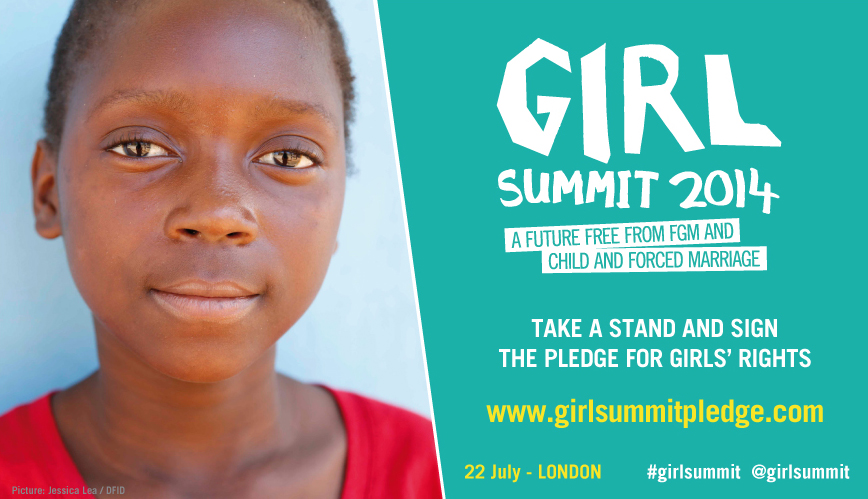 Further information: Dowry and Bride price Poster against child and forced marriage Poster against child and forced marriage A child marriage is a marriage where one or both spouses are under 18, a practice that disproportionately affects women.[209][210] Child marriages are most common in South Asia, the Middle East and Sub-Saharan Africa, but occur in other parts of the world, too. The practice of marrying young girls is rooted in patriarchal ideologies of control of female behavior and is also sustained by traditional practices such as dowry and bride price.[211] Child marriage is strongly connected with protecting female virginity.[212] UNICEF states that:[209] Marrying girls under 18 years old is rooted in gender discrimination, encouraging premature and continuous child bearing and giving preference to boys' education. Child marriage is also a strategy for economic survival as families marry off their daughters at an early age to reduce their economic burden. Consequences of child marriage include restricted education and employment prospects, increased risk of domestic violence, child sexual abuse, pregnancy and birth complications, and social isolation.[210][212] Early and forced marriage are defined as forms of modern-day slavery by the International Labour Organization.[213] In some cases, a woman or girl who has been raped may be forced to marry her rapist to restore the honor of her family;[214][215] marriage by abduction, a practice in which a man abducts the woman or girl whom he wishes to marry and rapes her to force the marriage is common in Ethiopia.[216][217][218] Military Further information: Conscription and sexism and Women in the military  New Zealand soldiers Conscription, or compulsory military service, has been criticized as sexist.[219]: 102 [220] During the Modern era, prior to the late 20th century, mostly men were subjected to conscription, although there were several instances of conscription of women in Antiquity and the Middle Ages.[221][222][219]: 255 [223][224][225][226] Today most countries still require only men to serve in the military. In his book The Second Sexism: Discrimination Against Men and Boys (2012), philosopher David Benatar states that "[t]he prevailing assumption is that where conscription is necessary, it is only men who should be conscripted and, similarly, that only males should be forced into combat". This, he believes, "is a sexist assumption".[219]: 102 Anthropologist Ayse Gül Altinay has commented that "given equal suffrage rights, there is no other citizenship practice that differentiates as radically between men and women as compulsory male conscription".[227]: 34 Only nine countries conscript women into their armed forces: China, Eritrea, Israel, Libya, Malaysia, North Korea, Norway, Peru, and Taiwan.[228][229] Other countries—such as Finland, Turkey, and Singapore—still use a system of conscription which requires military service from men only, although women may serve voluntarily. In 2014, Norway became the first NATO country to introduce obligatory military service for women as an act of gender equality[229][230] and in 2015, the Dutch government started preparing a gender-neutral draft law.[231] The gender selective draft has been challenged in the United States.[232] Conditions in the military have been described as "sexually abusive" and the "sexual persecution" of women.[233] Relentless sexist ridicule, hostility, and sexual harassment has been frequently reported.[234][235] Women in the military are more likely to be raped by a male fellow soldier than killed by the enemy.[236][237][238] Prosecution of the reported crimes fails to move forward, as the Pentagon claimed it would undermine the leadership of the commanders.[239][240] Domestic violence Further information: Honor killing, Acid throwing, and Dowry death 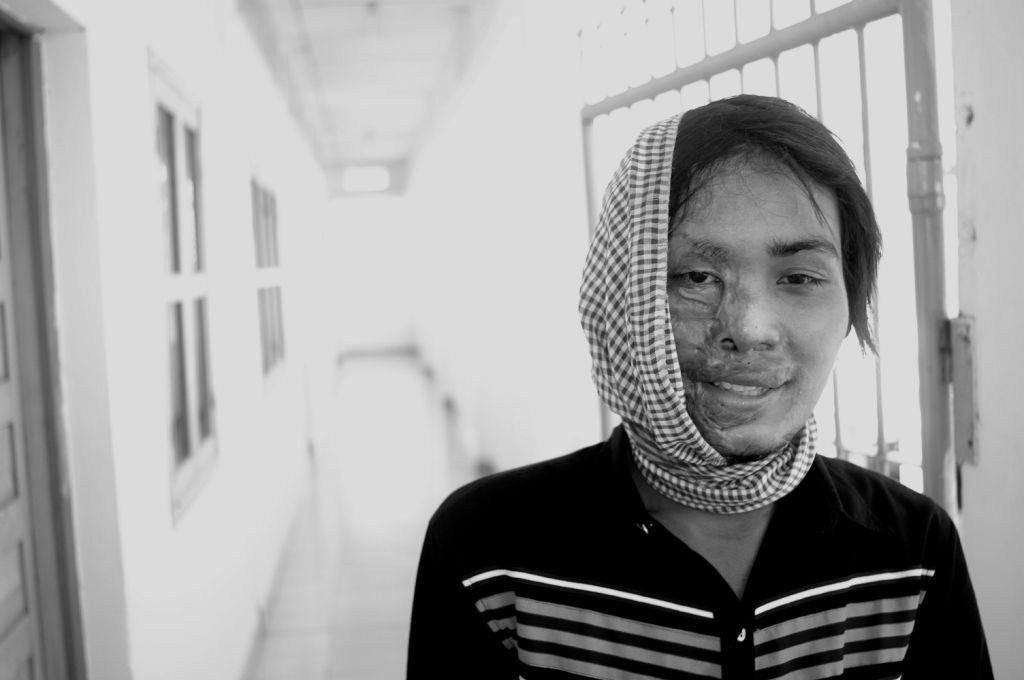 Portrait of a female acid attack victim showing facial injuries Acid attack victim in Cambodia Although the exact rates are widely disputed, there is a large body of cross-cultural evidence that domestic violence is mostly committed by men against women.[241][242][243] In addition, there is a broad consensus that women are more often subjected to severe forms of abuse and are more likely to be injured by an abusive partner.[242][243] The United Nations recognizes domestic violence as a form of gender-based violence, which it describes as a human rights violation, and the result of sexism.[244] Domestic violence is tolerated and even legally accepted in many parts of the world. For instance, in 2010, the United Arab Emirates (UAE)'s Supreme Court ruled that a man has the right to discipline his wife and children physically if he does not leave visible marks.[245] In 2015, Equality Now drew attention to a section of the Penal Code of Northern Nigeria, titled Correction of Child, Pupil, Servant or Wife which reads: "(1) Nothing is an offence which does not amount to the infliction of grievous hurt upon any persons which is done: (...) (d) by a husband for the purpose of correcting his wife, such husband and wife being subject to any native law or custom in which such correction is recognized as lawful."[246] Honor killings are another form of domestic violence practiced in several parts of the world, and their victims are predominantly women.[247] Honor killings can occur because of refusal to enter into an arranged marriage, maintaining a relationship relatives disapprove of, extramarital sex, becoming the victim of rape, dress seen as inappropriate, or homosexuality.[248][249][250] The United Nations Office on Drugs and Crime states that, "[h]onour crimes, including killing, are one of history's oldest forms of gender-based violence".[251] According to a report of the Special Rapporteur submitted to the 58th session of the United Nations Commission on Human Rights concerning cultural practices in the family that reflect violence against women: The Special Rapporteur indicated that there had been contradictory decisions with regard to the honor defense in Brazil, and that legislative provisions allowing for partial or complete defense in that context could be found in the penal codes of Argentina, Ecuador, Egypt, Guatemala, Iran, Israel, Jordan, Peru, Syria, Venezuela, and the Palestinian National Authority.[252] Practices such as honor killings and stoning continue to be supported by mainstream politicians and other officials in some countries. In Pakistan, after the 2008 Balochistan honor killings in which five women were killed by tribesmen of the Umrani Tribe of Balochistan, Pakistani federal minister for Postal Services Israr Ullah Zehri defended the practice:[253] "These are centuries-old traditions, and I will continue to defend them. Only those who indulge in immoral acts should be afraid."[254] Following the 2006 case of Sakineh Mohammadi Ashtiani (which has placed Iran under international pressure for its stoning sentences), Mohammad-Javad Larijani, a senior envoy and chief of Iran's Human Rights Council, defended the practice of stoning; he claimed it was a "lesser punishment" than execution, because it allowed those convicted a chance at survival.[255] Dowry deaths result from the killing of women who are unable to pay the high dowry price for their marriage. According to Amnesty International, "the ongoing reality of dowry-related violence is an example of what can happen when women are treated as property".[256] Education Main articles: Sex differences in education and Sexism in academia Women have traditionally had limited access to higher education.[257][page needed] In the past, when women were admitted to higher education, they were encouraged to major in less-scientific subjects; the study of English literature in American and British colleges and universities was instituted as a field considered suitable to women's "lesser intellects".[258][page needed] Educational specialties in higher education produce and perpetuate inequality between men and women.[259] Disparity persists particularly in computer and information science, where in the US women received only 21% of the undergraduate degrees, and in engineering, where women obtained only 19% of the degrees in 2008.[260] Only one out of five of physics doctorates in the US are awarded to women, and only about half those women are American.[261] Of all the physics professors in the country, only 14% are women.[261] As of 2019, women account for just 27% of all workers in STEM fields, and on average earn almost 20% less than men in the same industries.[262] World literacy is lower for females than for males. Data from The World Factbook shows that 79.7% of women are literate, compared to 88.6% of men (aged 15 and over).[263] In some parts of the world, girls continue to be excluded from proper public or private education. In parts of Afghanistan, girls who go to school face serious violence from some local community members and religious groups.[264] According to 2010 UN estimates, only Afghanistan, Pakistan and Yemen had less than 90 girls per 100 boys at school.[265] Jayachandran and Lleras-Muney's study of Sri Lankan economic development has suggested that increases in the life expectancy for women encourages educational investment because a longer time horizon increases the value of investments that pay out over time.[266] Educational opportunities and outcomes for women have greatly improved in the West. Since 1991, the proportion of women enrolled in college in the United States has exceeded the enrollment rate for men, and the gap has widened over time.[267] As of 2007, women made up the majority—54%—of the 10.8 million college students enrolled in the United States.[268] However, research by Diane Halpern has indicated that boys receive more attention, praise, blame and punishment in the grammar-school classroom,[269] and "this pattern of more active teacher attention directed at male students continues at the postsecondary level".[270] Over time, female students speak less in a classroom setting.[271] Teachers also tend to spend more time supporting the academic achievements of girls.[272] Boys are frequently diagnosed with ADHD, which some see as a result of school systems being more likely to apply these labels to males.[273] A recent study by the OECD in over 60 countries found that teachers give boys lower grades for the same work. The researchers attribute this to stereotypical ideas about boys and recommend teachers to be aware of this gender bias.[274] One study found that students give female professors worse evaluation scores than male professors, even though the students appear to do as well under female professors as male professors.[275] Gender bias and gender-based discrimination still permeate the education process in many settings. For example, in the teaching and learning process, including differential engagement, expectations and interactions by teachers with their male and female students, as well as gender stereotypes in textbooks and learning materials. There has been a lack in adequate resources and infrastructure to ensure safe and enabling learning environments, and insufficient policy, legal and planning frameworks, that respect, protect and fulfil the right to education.[276] Fashion See also: Foot binding and Burqa Further information: Gendered associations of pink and blue  Louis XV as a boy wearing a pink dress. Louis XV in 1712, a boy wearing a pink dress 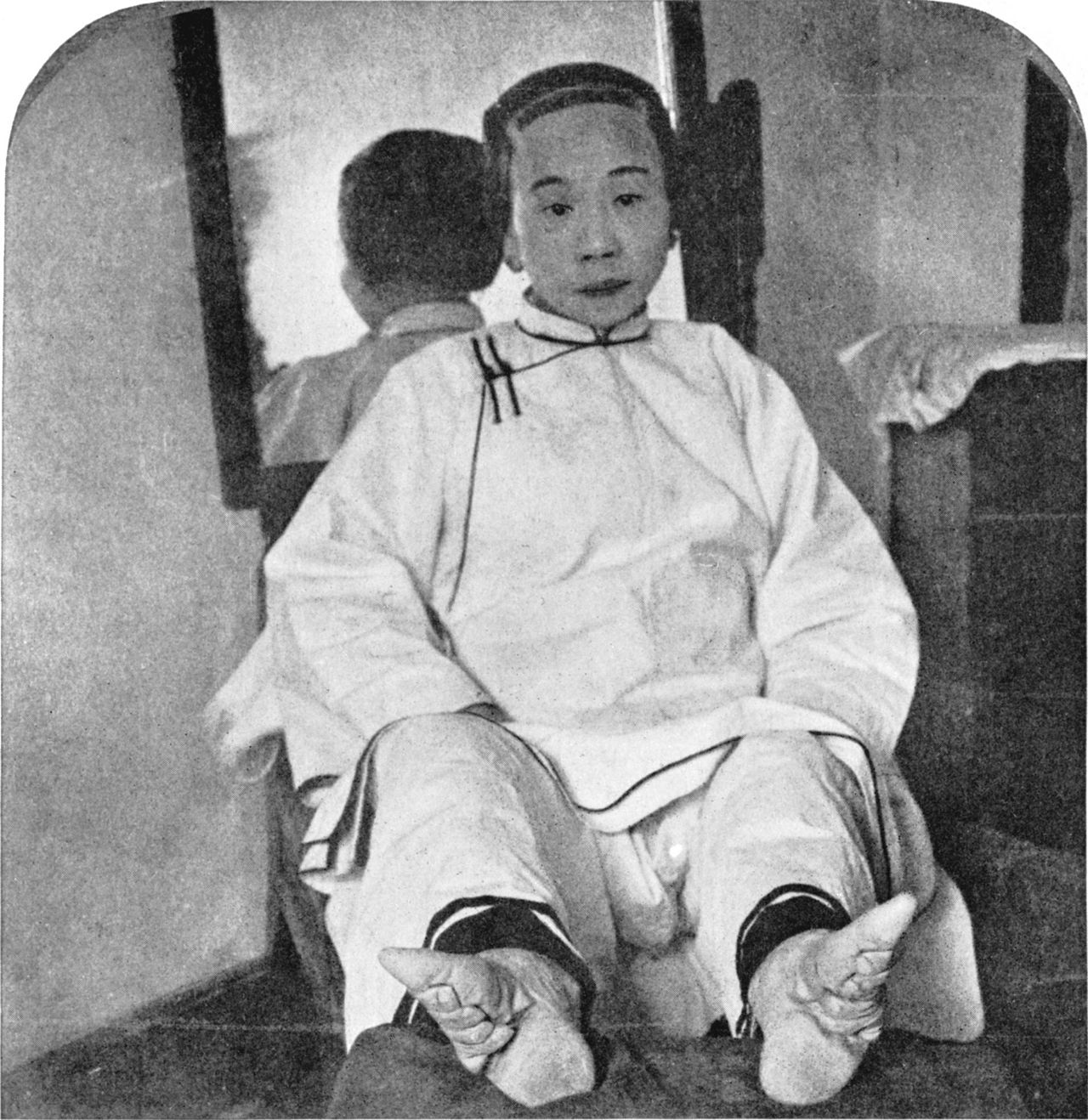 A Chinese woman shows the effects of foot binding on her feet. Chinese woman shows the effect of foot binding. Feminists argue that clothing and footwear fashion have been oppressive to women, restricting their movements, increasing their vulnerability, and endangering their health.[277] Using thin models in the fashion industry has encouraged the development of bulimia and anorexia nervosa, as well as locking female consumers into false feminine identities.[278] The assignment of gender-specific baby clothes can instill in children a belief in negative gender stereotypes.[279] One example is the assignment in some countries of the color pink to girls and blue to boys. The fashion is recent one. At the beginning of the 20th century the trend was the opposite: blue for girls and pink for boys.[280] In the early 1900s, The Women's Journal wrote that "pink being a more decided and stronger colour, is more suitable for the boy, while blue, which is more delicate and dainty, is prettier for the girl". DressMaker magazine also explained that "[t]he preferred colour to dress young boys in is pink. Blue is reserved for girls as it is considered paler, and the more dainty of the two colours, and pink is thought to be stronger (akin to red)".[281] Today, in many countries, it is considered inappropriate for boys to wear dresses and skirts, but this is also a relatively recent view. From the mid-16th century[282] until the late 19th or early 20th century, young boys in the Western world were unbreeched and wore gowns or dresses until an age that varied between two and eight.[283] Laws that dictate how women must dress are seen by many international human rights organizations, such as Amnesty International, as gender discrimination.[284] In many countries, women face violence for failing to adhere to certain dress codes, whether by the authorities (such as the religious police), family members, or the community.[285][286] Amnesty International states: Interpretations of religion, culture, or tradition cannot justify imposing rules about dress on those who choose to dress differently. States should take measures to protect individuals from being coerced to dress in specific ways by family members, community or religious groups or leaders.[284] The production process also faces criticism for sexist practices. In the garment industry, approximately 80 percent of workers are female.[287] Much garment production is located in Asia because of low labor costs. Women who work in these factories are sexually harassed by managers and male workers, paid low wages, and discriminated against when pregnant.[288] Female genital mutilation Main article: Female genital mutilation 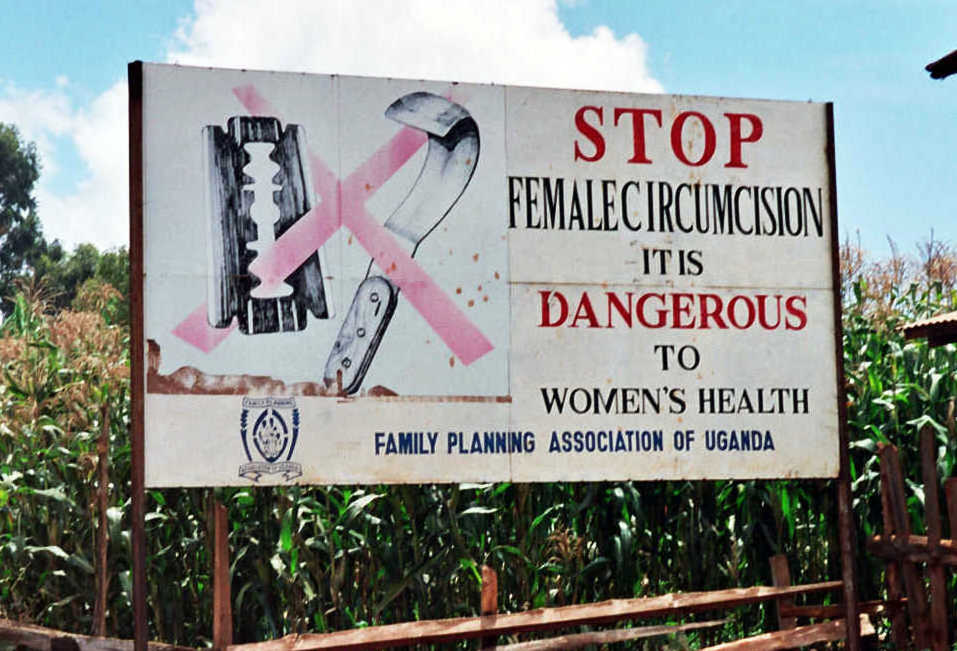 Campaign sign against female genital mutilation that reads:Stop Female Circumcision It is Dangerous to Women's Health Campaign against female genital mutilation in Uganda Female genital mutilation is defined by the World Health Organization (WHO) as "all procedures that involve partial or total removal of the external female genitalia, or other injury to the female genital organs for non-medical reasons". The WHO further states, "The practice has no health benefits for girls and women and [can] cause severe bleeding and problems urinating, and later cysts, infections, as well as complications in childbirth and increased risk of newborn deaths."[289] It "is recognized internationally as a violation of the human rights of girls and women" and "constitutes an extreme form of discrimination against women".[289] The European Parliament stated in a 2014 resolution that the practice "clearly goes against the European founding value of equality between women and men and maintains traditional values according to which women are seen as the objects and properties of men".[290] Gendercide and forced sterilization 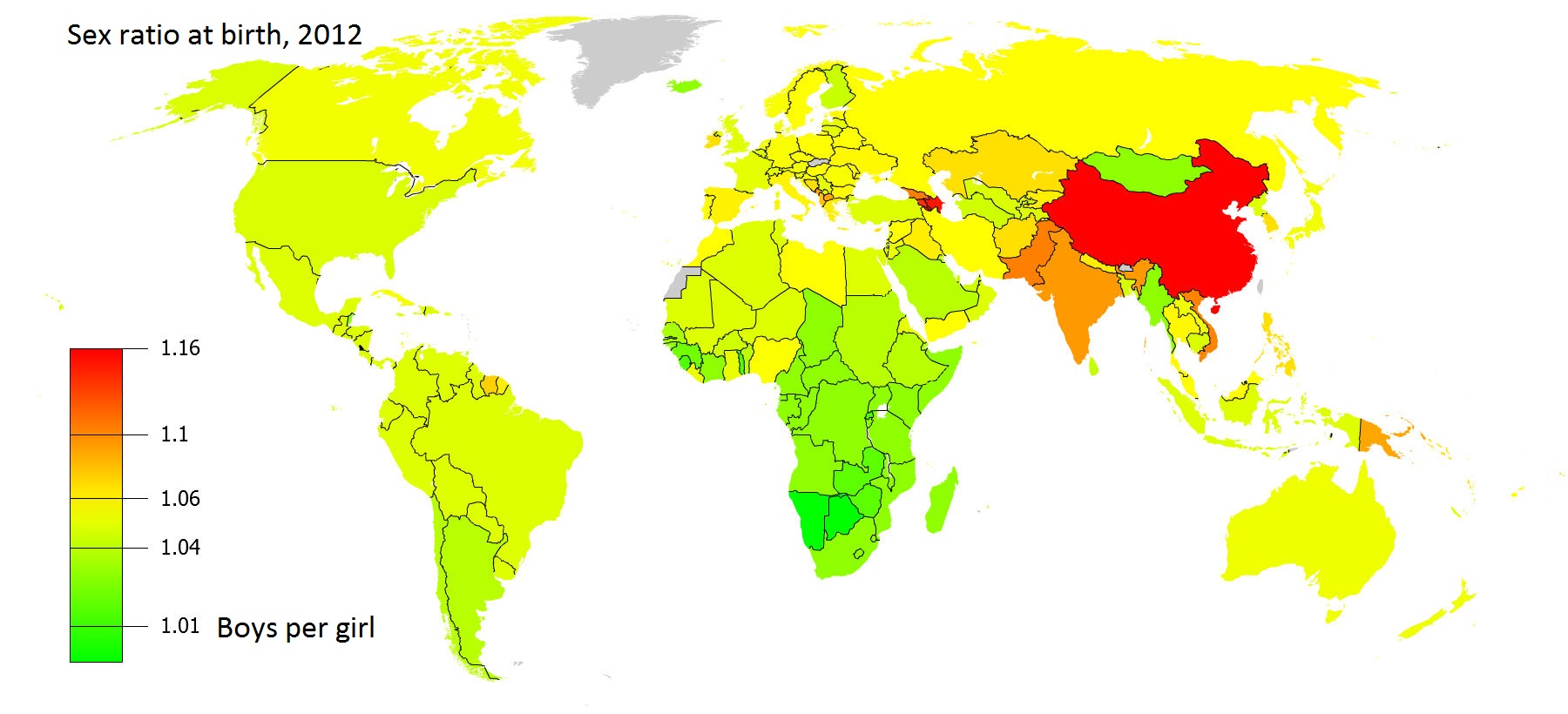 World map showing birth sex ratios World map of birth sex ratios, 2012 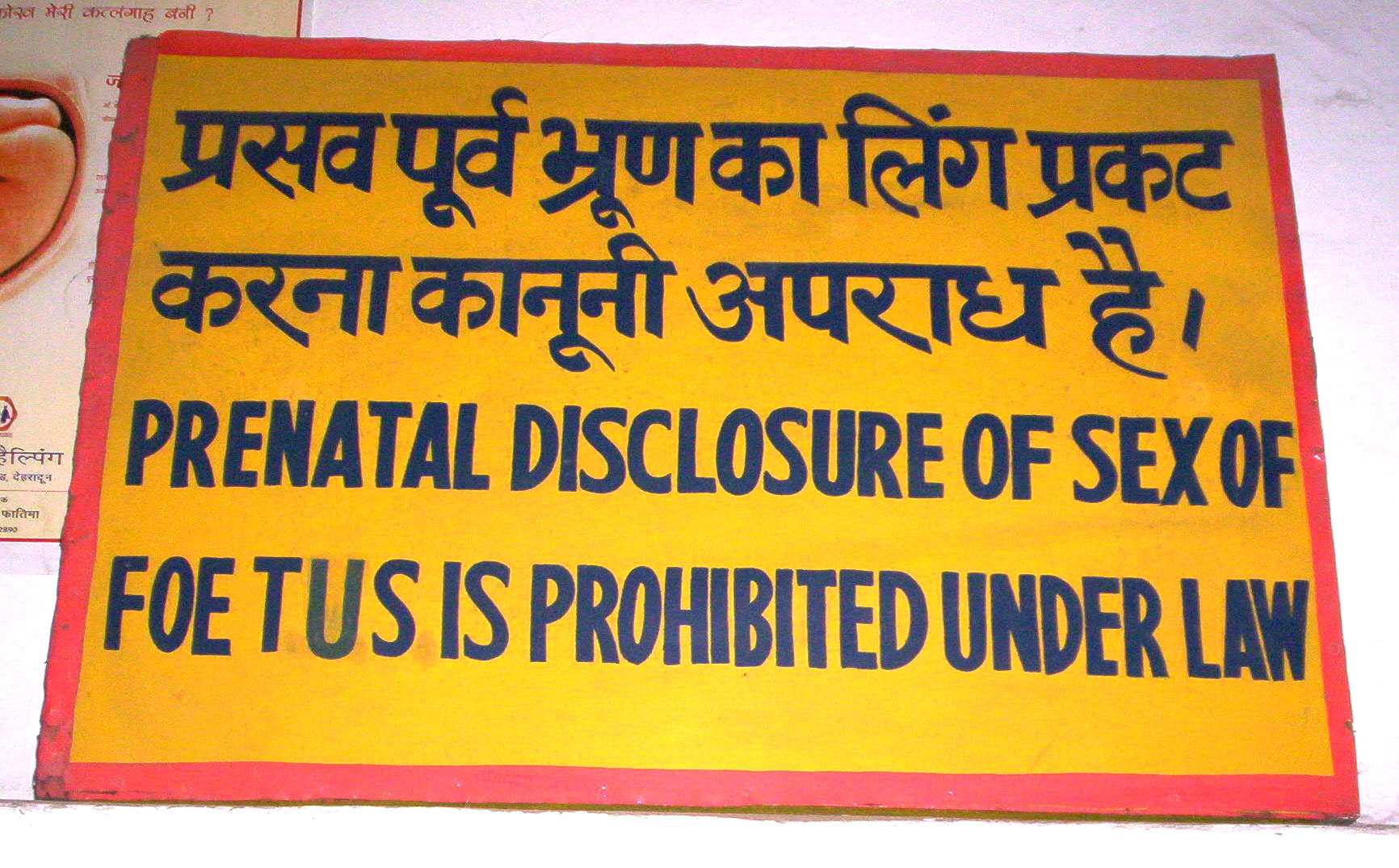 Sign in an Indian clinic reading "Prenatal disclosure of sex of foetues is prohibited under law" in English and Hindi. Roadside graffiti reading:"Crack down on medically unnecessary fetus sex identification and pregnancy termination practices."  "Crack down on medically unnecessary fetus sex identification and pregnancy termination practices." Female infanticide is the killing of newborn female children, while female selective abortion is the terminating of a pregnancy based upon the female sex of the fetus. Gendercide is the systematic killing of members of a specific gender and it is an extreme form of gender-based violence.[291][292][293] Female infanticide is more common than male infanticide, and is especially prevalent in South Asia, in countries such as China, India and Pakistan.[292][294][295] Recent studies suggest that over 90 million women and girls are missing in China and India as a result of infanticide.[296][297] Sex-selective abortion involves terminating a pregnancy based upon the predicted sex of the baby. The abortion of female fetuses is most common in areas where a culture values male children over females,[298] such as parts of East Asia and South Asia (China, India, Korea), the Caucasus (Azerbaijan, Armenia and Georgia), and Western Balkans (Albania, Macedonia, Montenegro, Kosovo).[298][299] One reason for this preference is that males are seen as generating more income than females. The trend has grown steadily over the previous decade, and may result in a future shortage of women.[300] Forced sterilization and forced abortion are also forms of gender-based violence.[291] Forced sterilization was practiced during the first half of the 20th century by many Western countries and there are reports of this practice being currently employed in some countries, such as Uzbekistan and China.[301][302][303][304] In China, the one child policy interacting with the low status of women has been deemed responsible for many abuses, such as female infanticide, sex-selective abortion, abandonment of baby girls, forced abortion, and forced sterilization.[305][306] In India, the custom of dowry is strongly related to female infanticide, sex-selective abortion, abandonment and mistreatment of girls.[307] Such practices are especially present in the northwestern part of the country: Jammu and Kashmir, Haryana, Punjab, Uttarakhand and Delhi. (See Female foeticide in India and Female infanticide in India). Legal justice and regulations 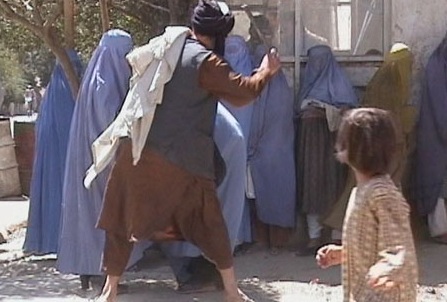 A Taliban religious policeman beating a woman because she removed her burqa in public. Member of the Taliban's religious police beating an Afghan woman in Kabul on August 26, 2001. State violence against women is a form of discrimination. In several Organisation of Islamic Cooperation (OIC) countries the legal testimony of a woman is worth legally half of that of a man (see Status of women's testimony in Islam). Such countries include: Algeria (in criminal cases), Bahrain (in Sharia courts), Egypt (in family courts), Iran (in most cases), Iraq (in some cases), Jordan (in Sharia courts), Kuwait (in family courts), Libya (in some cases), Morocco (in family cases), Palestine (in cases related to marriage, divorce and child custody), Qatar (in family law matters), Syria (in Sharia courts), United Arab Emirates (in some civil matters), Yemen (not allowed to testify at all in cases of adultery and retribution), and Saudi Arabia.[308][309] Such laws have been criticized by Human Rights Watch and Equality Now as being discriminatory towards women.[310][311] The criminal justice system in many common law countries has also been accused of discriminating against women. Provocation is, in many common law countries, a partial defense to murder, which converts what would have been murder into manslaughter. It is meant to be applied when a person kills in the "heat of passion" upon being "provoked" by the behavior of the victim. This defense has been criticized as being gendered, favoring men, because of it being used disproportionately in cases of adultery, and other domestic disputes when women are killed by their partners. As a result of the defense exhibiting a strong gender bias, and being a form of legitimization of male violence against women and minimization of the harm caused by violence against women, it has been abolished or restricted in several jurisdictions.[312][313] The traditional leniency towards crimes of passion in Latin American countries has been deemed to have its origin in the view that women are property.[314] In 2002, Widney Brown, advocacy director for Human Rights Watch, stated that, "[S]o-called crimes of passion have a similar dynamic [to honor killings] in that the women are killed by male family members and the crimes are perceived as excusable or understandable."[314] The Office of the United Nations High Commissioner for Human Rights (OHCHR) has called for "the elimination of discriminatory provisions in the legislation, including mitigating factors for 'crimes of passion'."[315] In the United States, some studies have shown that for identical crimes, men are given harsher sentences than women. Controlling for arrest offense, criminal history, and other pre-charge variables, sentences are over 60% heavier for men. Women are more likely to avoid charges entirely, and to avoid imprisonment if convicted.[316][317] The gender disparity varies according to the nature of the case. For example, the gender gap is less pronounced in fraud cases than in drug trafficking and firearms. This disparity occurs in US federal courts, despite guidelines designed to avoid differential sentencing.[318] The death penalty may also suffer from gender bias. According to Shatz and Shatz, "[t]he present study confirms what earlier studies have shown: that the death penalty is imposed on women relatively infrequently and that it is disproportionately imposed for the killing of women".[319] There have been several reasons postulated for the gender criminal justice disparity in the United States. One of the most common is the expectation that women are predominantly care-givers.[316][317][318] Other possible reasons include the "girlfriend theory" (whereby women are seen as tools of their boyfriends),[317] the theory that female defendants are more likely to cooperate with authorities,[317] and that women are often successful at turning their violent crime into victimhood by citing defenses such as postpartum depression or battered wife syndrome.[320] However, none of these theories account for the total disparity,[317] and sexism has also been suggested as an underlying cause.[321] Gender discrimination also helps explain the differences between trial outcomes in which some female defendants are sentenced to death and other female defendants are sentenced to lesser punishments. Phillip Barron argues that female defendants are more likely to be sentenced to death for crimes that violate gender norms, such as killing children or killing strangers.[322] Transgender people face widespread discrimination while incarcerated. They are generally housed according to their legal birth sex, rather than their gender identity. Studies have shown that transgender people are at an increased risk for harassment and sexual assault in this environment. They may also be denied access to medical procedures related to their reassignment.[323] Some countries use stoning as a form of capital punishment. According to Amnesty International, the majority of those stoned are women and women are disproportionately affected by stoning because of sexism in the legal system.[324] One study found that: [O]n average, women receive lighter sentences in comparison with men ... roughly 30% of the gender differences in incarceration cannot be explained by the observed criminal characteristics of offense and offender. We also find evidence of considerable heterogeneity across judges in their treatment of female and male offenders. There is little evidence, however, that tastes for gender discrimination are driving the mean gender disparity or the variance in treatment between judges.[325] A 2017 study by Knepper found that "female plaintiffs filing workplace sex discrimination claims are substantially more likely to settle and win compensation whenever a female judge is assigned to the case. Additionally, female judges are 15 percentage points less likely than male judges to grant motions filed by defendants, which suggests that final negotiations are shaped by the emergence of the bias."[326] Reproductive rights Main article: Reproductive rights The United Nations Population Fund writes that, "Family planning is central to gender equality and women's empowerment".[327] Women in many countries around the world are denied medical and informational services related to reproductive health, including access to pregnancy care, family planning, and contraception.[327][328] In countries with very strict abortion laws (particularly in Latin America) women who suffer miscarriages are often investigated by the police under suspicion of having deliberately provoked the miscarriage and are sometimes jailed,[329] a practice which Amnesty International called a "ruthless campaign against women's rights".[330] Doctors may be reluctant to treat pregnant women who are very ill, because they are afraid the treatment may result in fetal loss.[331] According to Amnesty International, "Discriminatory attitudes towards women and girls also means access to sex education and contraceptives are near impossible [in El Salvador]".[332] The organization has also criticized laws and policies which require the husband's consent for a woman to use reproductive health services as being discriminatory and dangerous to women's health and life: "[F]or the woman who needs her husband's consent to get contraception, the consequences of discrimination can be serious—even fatal".[333] Sexual assault and treatment of victims Main articles: Sexual assault and Post-assault treatment of sexual assault victims 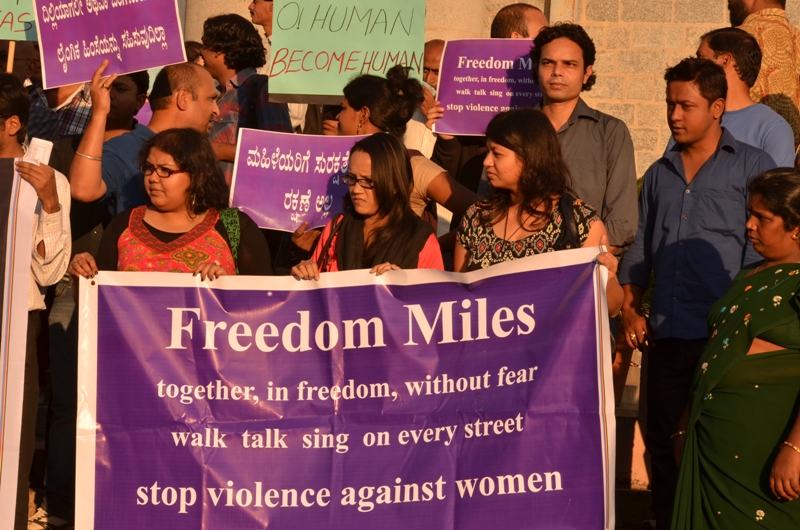 People carrying a banner marching in a protest against gang rape People in Bangalore, India, demanding justice for a student gang-raped in Delhi in 2012 Research by Lisak and Roth into factors motivating perpetrators of sexual assault, including rape, against women revealed a pattern of hatred towards women and pleasure in inflicting psychological and physical trauma, rather than sexual interest.[334] Mary Odem and Peggy Reeves Sanday posit that rape is the result not of pathology but of systems of male dominance, cultural practices and beliefs.[335] Odem, Jody Clay-Warner, and Susan Brownmiller argue that sexist attitudes are propagated by a series of myths about rape and rapists.[336]: 130–140 [337] They state that in contrast to those myths, rapists often plan a rape before they choose a victim[336] and acquaintance rape (not assault by a stranger) is the most common form of rape.[336]: xiv [338] Odem also asserts that these rape myths propagate sexist attitudes about men, by perpetuating the belief that men cannot control their sexuality.[336] Sexism can promote the stigmatization of women and girls who have been raped and inhibit recovery.[214] In many parts of the world, women who have been raped are ostracized, rejected by their families, subjected to violence, and—in extreme cases—may become victims of honor killings because they are deemed to have brought shame upon their families.[214][339] The criminalization of marital rape is very recent, having occurred during the past few decades; in many countries it is still legal. Several countries in Eastern Europe and Scandinavia made spousal rape illegal before 1970; other European countries and some English-speaking countries outside Europe outlawed it later, mostly in the 1980s and 1990s;[340] some countries outlawed it in the 2000s.[341] The WHO wrote that: "Marriage is often used to legitimize a range of forms of sexual violence against women. The custom of marrying off young children, particularly girls, is found in many parts of the world. This practice—legal in many countries—is a form of sexual violence, since the children involved are unable to give or withhold their consent".[214] In countries where fornication or adultery are illegal, victims of rape can be charged criminally.[342] War rape Main article: War rape 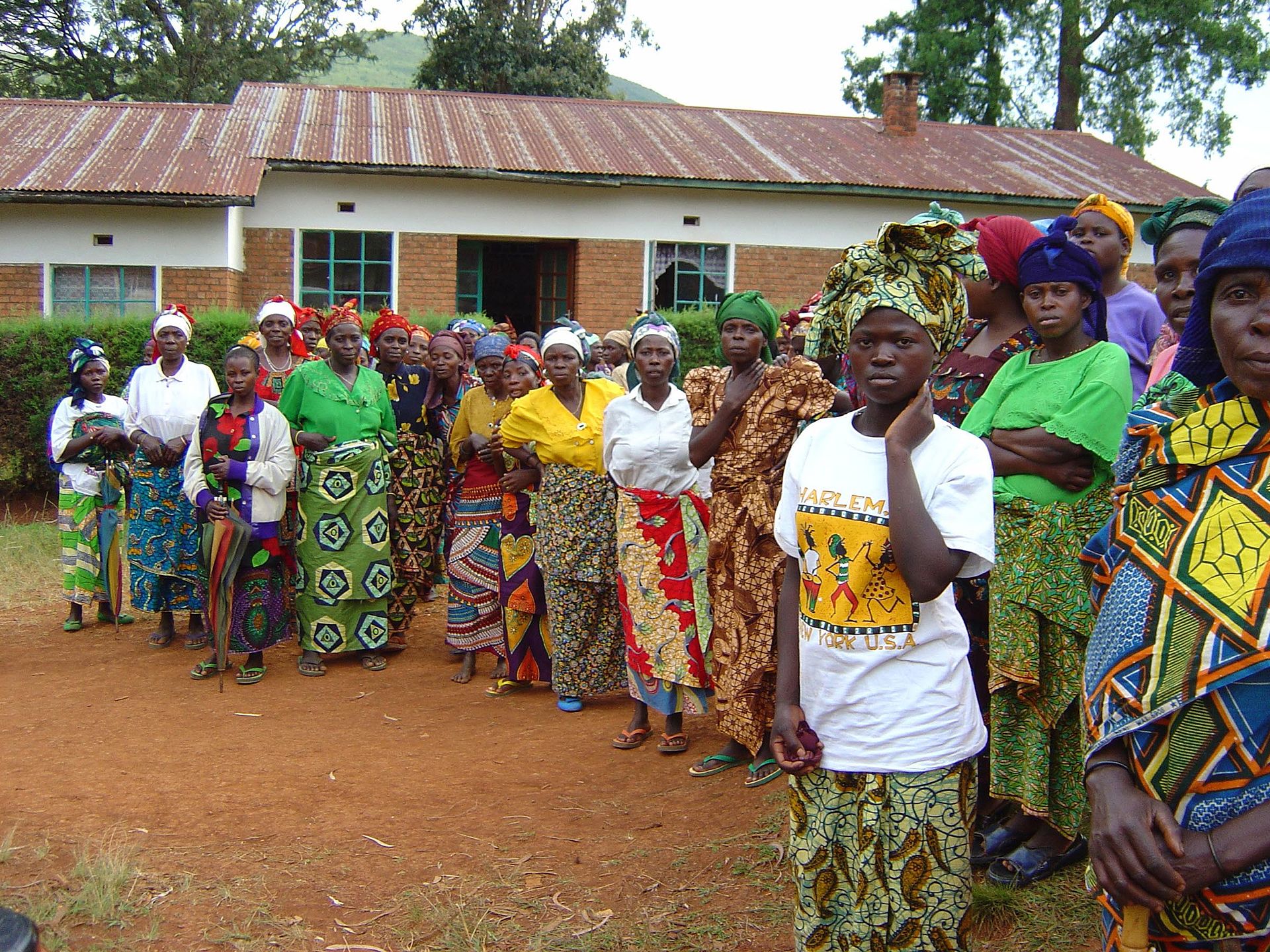 Female rape victims stand in front of a "peace hut". Meeting of victims of sexual violence in the Democratic Republic of the Congo Sexism is manifested by the crime of rape targeting women civilians and soldiers, committed by soldiers, combatants or civilians during armed conflict, war or military occupation. This arises from the long tradition of women being seen as sexual booty and from the misogynistic culture of military training.[343][344] |
実例 児童婚と強制結婚 詳細は:児童婚と強制結婚 さらに詳しい情報:持参金と花嫁の値段  児童婚と強制結婚に反対するポスター 児童婚と強制結婚に反対するポスター 児童婚とは、夫婦のどちらか、あるいは両方が18歳未満である結婚のことで、この慣習は女性に不均衡な影響を与える。児童婚は南アジア、中東、サハラ以南 のアフリカで最も一般的であるが、世界の他の地域でも見られる。幼い少女との結婚という慣習は、女性の行動を管理するという家父長的観念に根ざしており、 持参金や花嫁の値段といった伝統的慣習によっても維持されている。[211] 児童婚は、女性の処女性を守るという考えと強く結びついている。[212] UNICEFは次のように述べている。[209] 18歳未満の少女との結婚は、性差別を根拠としており、早すぎる妊娠と継続的な妊娠を助長し、男子の教育を優先するものである。また、経済的な負担を軽減 するために、娘を早期に結婚させるという経済的な生存戦略でもある。 児童婚の結果として、教育や就職の機会が制限されたり、家庭内暴力のリスクが高まったり、児童性的虐待、妊娠や出産に伴う合併症、社会的孤立などが生じる 可能性がある。[210][212] 早期の強制結婚は、国際労働機関(ILO)によって現代の奴隷制の一形態と定義されている。[213] レイプ被害に遭った女性や少女が、 家族の名誉を回復するために、レイプ犯と結婚させられることもある。[214][215] エチオピアでは、結婚を望む男性が結婚相手となる女性または少女を誘拐し、レイプして結婚を強要する誘拐結婚が一般的である。[216][217] [218] 軍隊 さらに詳しい情報: 徴兵制と性差別、軍隊における女性  ニュージーランドの兵士 徴兵制、すなわち兵役義務は性差別的であると批判されている。[219]:102[220] 近代において、20世紀後半以前は、ほとんどの男性が徴兵制の対象となっていたが、 古代や中世では、女性も徴兵された例がいくつかあるが[221][222][219]: 255 [223][224][225][226] 今日でもほとんどの国では、男性のみに兵役が義務付けられている。 哲学者のデビッド・ベナターは著書『第二の性差別:男性と少年に対する差別』(2012年)の中で、「徴兵制が必要な場合、徴兵されるべきは男性のみであ り、同様に、戦闘に駆り出されるべきも男性のみであるというのが一般的な考え方である」と述べている。これは「性差別的な思い込み」であると彼は考えてい る。[219]:102 人類学者のアイシェ・ギュル・アルティナイは、「平等な選挙権が与えられている場合、男性と女性をこれほどまでに根本的に区別する市民権の慣行は、男性の 強制徴兵制以外にはない」と述べている。[227]:34 女性を軍隊に徴兵しているのは、中国、エリトリア、イスラエル、リビア、マレーシア、北朝鮮、ノルウェー、ペルー、台湾の9カ国のみである。[228] [229] フィンランド、トルコ、シンガポールなどの国々では、男性のみに兵役を義務付ける徴兵制度が今も採用されているが、女性は志願すれば兵役につくことができ る。2014年には、ノルウェーがジェンダー平等政策の一環として、女性に対する義務的兵役を導入した最初のNATO加盟国となった[229] [230]。2015年には、オランダ政府がジェンダーニュートラルな徴兵法案の準備を開始した[231]。性別による徴兵差別は、アメリカ合衆国でも問 題となっている[232]。 軍隊の状況は「性的虐待」であり、女性に対する「性的迫害」であると表現されている。[233] 執拗な性差別的嘲笑、敵意、セクハラが頻繁に報告されている。[234][235] 軍隊の女性は、 敵に殺されるよりも、男性の兵士にレイプされる可能性が高い。[236][237][238] 報告された犯罪の訴追は、ペンタゴンが指揮官のリーダーシップを損なうと主張したため、進展していない。[239][240] 家庭内暴力 詳細は「名誉殺人」、「硫酸攻撃」、「持参金殺人」を参照  顔面損傷を示す硫酸攻撃被害者の肖像画 カンボジアの硫酸攻撃被害者 正確な発生率については広く論争があるが、家庭内暴力は主に男性から女性に対して行われるという異文化間の証拠が数多く存在している。[241] [242][243] さらに、女性の方が深刻な虐待を受けやすく、 虐待の深刻な被害を受けやすく、虐待を行うパートナーによって負傷する可能性が高いという点で、幅広い合意が存在している。[242][243] 国連は家庭内暴力をジェンダーに基づく暴力の一形態として認識しており、これは人権侵害であり、性差別主義の結果であると説明している。[244] 家庭内暴力は世界中の多くの地域で容認され、法的に認められていることさえある。例えば、2010年にはアラブ首長国連邦(UAE)の最高裁が、目に見え る傷を残さない限り、男性には妻や子供を肉体的にしつける権利があるとの判決を下している。2015年には、Equality Nowが、北部ナイジェリアの刑法の「児童、生徒、使用人、または妻の矯正」と題された条項に注目した。「(1) 以下の行為は、いかなる者に対しても重傷を負わせるほどの傷害を加えることには至らないため、犯罪とはならない。(...)(d) 妻を躾ける目的で夫が行う場合。ただし、当該の躾が合法であると認められている慣習法や慣習に従う場合に限る。」[246] 名誉殺人は、世界のいくつかの地域で発生している家庭内暴力の別の形態であり、その犠牲者の大半は女性である。[247] 名誉殺人は、見合い結婚を拒否したこと、親族が反対する関係を維持したこと、婚外交渉、レイプの被害者となったこと、 不適切な服装と見なされた場合、あるいは同性愛である場合などである。[248][249][250] 国連薬物犯罪事務所は、「名誉殺人を含む名誉犯罪は、歴史上最も古いジェンダーに基づく暴力のひとつである」と述べている。[251] 女性に対する暴力を反映する家族内の文化的慣習に関する国連人権委員会第58回会期に提出された特別報告者の報告書によると、 特別報告者は、ブラジルにおける名誉防衛に関しては矛盾する判決が出されていることを指摘し、その文脈において部分的または完全な弁護を認める法規定は、 アルゼンチン、エクアドル、エジプト、グアテマラ、イラン、イスラエル、ヨルダン、ペルー、シリア、ベネズエラ、パレスチナ自治政府の刑法に見られると述 べた。[252] 名誉殺人や石打ち刑などの慣習は、一部の国々では主流派の政治家やその他の政府高官によって今も支持されている。パキスタンでは、2008年にバルーチス ターン州で5人の女性が同州のウマルニー族の部族民によって殺害されたバルーチスターン名誉殺人事件の後、郵便事業担当の連邦大臣イスラール・ウッラー・ ゼーリは、この慣習を擁護した。「これは何世紀も続く伝統であり、私は今後もそれを擁護していく。不道徳な行為にふける者だけが恐れるべきである」 [254] 2006年のサキネ・モハマディ・アシュティアニのケース(イランが石打ち刑を科したことで国際的な圧力を受けた)を受け、モハンマド・ジャヴァド・ラリ ジャニ イランの最高特使であり人権評議会の議長であるモハンマド・ジャヴァド・ラリジャニは、石打ちの刑を擁護した。彼は、有罪判決を受けた者に生き延びるチャ ンスを与えるという理由で、石打ちの刑は死刑よりも「軽い刑罰」であると主張した。 持参金殺人とは、結婚のために高額な持参金を支払うことができない女性が殺害されることである。アムネスティ・インターナショナルによると、「持参金に関 連する暴力が現在も続いていることは、女性が所有物として扱われるとどうなるかを示している」[256]。 教育 主な記事:教育における男女差、学問における性差別 女性は伝統的に高等教育へのアクセスが限られていた。[257][要ページ番号] 過去において、女性が高等教育を受けることが認められた場合、より非科学的な科目を専攻することが奨励されていた。アメリカやイギリスの大学では、英文学 の研究は女性の「劣った知性」にふさわしい分野として位置づけられていた。[258][要ページ番号] 高等教育における教育専門分野は男女間の不平等を生み出し、永続させている。[259] 特にコンピュータおよび情報科学の分野では格差が根強く、米国では学部課程の学位取得者のうち女性は21%に過ぎず、また工学分野では2008年には学位 取得者のうち女性は19%に過ぎなかった。[260] 米国では物理学博士号取得者の5人に1人だけが 女性に授与されており、そのうちの約半数がアメリカ人である。[261] その国の物理学教授のすべてにおいて、女性はわずか14%である。[261] 2019年現在、女性はSTEM分野の全労働者のわずか27%を占めており、同じ業界の男性よりも平均して20%近く収入が少ない。[262] 世界の識字率は、男性よりも女性の方が低い。世界ファクトブックのデータによると、15歳以上の男性の88.6%が読み書きできるのに対し、女性の 79.7%が読み書きできる。[263]世界のいくつかの地域では、少女たちが適切な公教育や私立教育から排除され続けている。アフガニスタンの一部で は、学校に通う少女たちは、地域社会の一部の住民や宗教団体から深刻な暴力を受けている。[264] 2010年の国連の推計によると、学校に通う男子100人に対して女子が90人未満であるのはアフガニスタン、パキスタン、イエメンだけである。 265] スリランカの経済発展に関するJayachandranとLleras-Muneyの研究では、女性の平均余命が延びることで、長期的な投資価値が高まる ため、教育投資が促進されることが示唆されている。 欧米では、女性の教育機会と成果は大幅に改善している。1991年以来、米国では大学に入学する女性の割合が男性の割合を上回り、その差は年々広がってい る。2007年現在、 米国の大学生1,080万人のうち、54%を女性が占めている。[268] しかし、ダイアン・ハルパーンによる研究では、男子生徒の方が文法学校の教室でより多くの注意、賞賛、非難、罰を受けていることが示されている。 [269] また、「 男性生徒により積極的な教師の関心が向けられるというパターンは、中等教育後も継続する」という結果が出ている。[270] 時が経つにつれ、女子生徒は教室で発言することが少なくなる。[271] 教師も女子生徒の学業達成を支援することに多くの時間を費やす傾向にある。[272] 男子生徒は頻繁にADHDと診断されるが、これは学校制度がこれらのレッテルを男子に貼る傾向が強い結果であると見る者もいる。[273] 60カ国以上を対象としたOECDの最近の研究では、教師が男子生徒の同じ課題に対して女子生徒よりも低い成績をつけていることが分かった。研究者たち は、この原因を男児に対する固定観念に求め、教師たちにこの性差別的バイアスを認識するよう勧めている。[274] ある研究では、学生たちは、女性教授の下でも男性教授の下でも同様に学業成績を上げているにもかかわらず、女性教授に対して男性教授よりも低い評価スコア をつけていることが分かった。[275] 性別による偏見や性別に基づく差別は、多くの場面で教育過程に依然として浸透している。例えば、教師が男子生徒と女子生徒に対して異なる関わり方や期待、 相互作用を行うこと、また教科書や教材における性別による固定観念など、教育と学習の過程においてである。安全で充実した学習環境を確保するための適切な 資源やインフラが不足しており、教育を受ける権利を尊重し、保護し、実現するための政策、法律、計画の枠組みも不十分である。 ファッション 参照:纏足とブルカ さらに詳しい情報:ピンクとブルーの性別による関連付け  少年時代のルイ15世はピンクのドレスを着用していた。 1712年のルイ15世はピンクのドレスを着用していた少年であった  中国人の女性が、纏足による足への影響を示している。 中国女性が纏足の効果を示している。 フェミニストは、衣類や履物のファッションが女性に対して抑圧的であり、女性の動きを制限し、脆弱性を高め、健康を危険に晒していると主張している。 [277] ファッション業界で細身のモデルが使われることで、過食症や神経性無食欲症の発症を促し、また女性消費者を偽りの女性的アイデンティティに閉じ込めてい る。[278] 性別による区別のあるベビー服を着せることは、子どもに否定的な性別固定観念を植え付けることになる。[279] その一例として、一部の国々では、女の子にはピンク、男の子には青を割り当てている。このファッションは最近のものである。20世紀初頭には、その傾向は 逆で、女の子には青、男の子にはピンクが好まれていた。[280] 1900年代初頭、『ザ・ウーマンズ・ジャーナル』誌は、「ピンクはより鮮明で力強い色であるため、男の子によりふさわしく、一方、青はより繊細で可憐な 色であるため、女の子によりふさわしい」と記している。また、『ドレスメーカー』誌も、「幼い男の子に着せる服に好まれる色はピンクである。青は2つの色 のうち淡く、より可憐な色とみなされるため、女の子用として取っておかれ、ピンクはより強い色(赤に近い)と考えられている」と説明している。[281] 今日では、多くの国々で、男の子がドレスやスカートを着用することは不適切であると考えられているが、これも比較的最近になってからの見方である。16世 紀半ばから[282]19世紀後半から20世紀初頭にかけて、西洋世界では幼い少年たちが2歳から8歳までの間、男子であるにもかかわらずガウンやドレス を着用していた。 女性がどのような服装をすべきかを定める法律は、アムネスティ・インターナショナルなどの多くの国際人権団体から性差別であると見なされている。 [284] 多くの国々では、当局(宗教警察など)、家族、または地域社会によって、女性が特定の服装規定に従わないことに対して暴力が振るわれている。[285] [286] アムネスティ・インターナショナルは次のように述べている。 宗教、文化、伝統の解釈は、異なる服装を選ぶ人々に対して服装に関する規則を押し付けることを正当化することはできない。国家は、家族、地域社会、宗教団 体や指導者によって特定の服装を強制されることのないよう個人を保護する措置を講じるべきである。 生産工程もまた、性差別的慣行に対する批判に直面している。 衣料品産業では、労働者の約80パーセントが女性である。[287] 多くの衣料品生産は、人件費が安いことを理由にアジアで行われている。 これらの工場で働く女性は、経営者や男性労働者からセクハラを受け、低賃金で働かされ、妊娠すると差別される。[288] 女性器切除 詳細は「女性器切除」を参照  女性器切除反対キャンペーンの看板:女性性器切除をやめよう。女性の健康にとって危険である ウガンダにおける女性器切除反対キャンペーン 女性器切除は世界保健機関(WHO)によって「非医療的理由による女性器の外側の部分または全部の切除、あるいは女性器へのその他の傷害を伴うあらゆる処 置」と定義されている。さらにWHOは、「この慣習は少女や女性にとって何ら健康上の利益をもたらすものではなく、重度の出血や排尿障害、後に嚢胞や感染 症、さらには出産時の合併症や新生児の死亡リスクを高める可能性がある」と述べている。[289] また、「少女や女性の基本的人権の侵害として国際的に認識されており」、 「女性に対する極端な差別」であるとされている。[289] 欧州議会は2014年の決議で、この慣行は「明らかに男女平等という欧州の創設的価値に反するものであり、女性は男性の所有物や財産であるという伝統的価 値観を維持するものである」と述べた。[290] ジェンダー・サイードと強制不妊手術  出生時の男女比を示す世界地図 2012年の出生時の男女比を示す世界地図  英語とヒンディー語で「胎児の性別を出生前に告知することは法律で禁止されている」と書かれたインドのクリニックのサイン。  「医学的に不要な胎児の性別識別と妊娠中絶の慣行を取り締まれ」と書かれた道路脇の落書き。 「医学的に不要な胎児の性別識別と妊娠中絶の慣行を取り締まれ」 女児殺しとは新生女児の殺害であり、女児選択中絶とは胎児が女児であることを理由とした妊娠中絶である。ジェンダー殺しとは特定の性別の者を組織的に殺害 することであり、ジェンダーに基づく暴力の極端な形態である。[291][292][293] 女児殺しは男児殺しよりも一般的であり、特に南アジア 、中国、インド、パキスタンなどの国々で特に多く見られる。[292][294][295] 最近の研究では、女児殺しの結果、中国とインドでは9,000万人以上の女性と女児が行方不明になっていることが示唆されている。[296][297] 性別選択中絶は、生まれてくる子供の性別を予測して妊娠を中絶することである。女児の胎児の人工妊娠中絶は、東アジアや南アジア(中国、インド、韓国)の 一部、コーカサス(アゼルバイジャン、アルメニア、グルジア)、西バルカン半島(アルバニア、マケドニア、モンテネグロ、コソボ)など、男児を女児よりも 重視する文化を持つ地域で最も多く見られる。[298][299] この傾向の理由の一つは、男児の方が女児よりも多くの収入をもたらすと考えられていることである。この傾向は過去10年間で着実に増加しており、将来的に 女性が不足する可能性もある。 強制不妊手術と強制中絶もまた、ジェンダーに基づく暴力の一形態である。[291] 強制不妊手術は20世紀前半に多くの西洋諸国で実施されていたが、現在でもウズベキスタンや中国など一部の国々でこの慣行が用いられているという報告があ る。[301][302][303][304] 中国では、女性の地位の低さと相まって、一人っ子政策が、女児の殺害、性別選択中絶、女児の遺棄、強制中絶、強制不妊手術など、多くの虐待の原因となって いるとみなされている。 インドでは、持参金の習慣が女児の殺害、性別選択中絶、女児の遺棄や虐待と強く関連している。[307] このような慣行は、特に同国の北西部、すなわちジャンムー・カシミール州、ハリヤーナー州、パンジャーブ州、ウッタラーカンド州、デリーで多く見られる。 (インドにおける女児殺し、インドにおける女児の殺害を参照) 法的正義と規制  公共の場でブルカを脱いだために、タリバンの宗教警察官に殴られている女性。 2001年8月26日、カブールでアフガニスタンの女性を殴るタリバンの宗教警察官。女性に対する国家による暴力は、差別の一形態である。 イスラム協力機構(OIC)加盟国のいくつかでは、女性の法的証言は、法的には男性の半分とみなされる(イスラムにおける女性の証言の地位を参照)。その ような国には以下が含まれる:アルジェリア(刑事事件)、バーレーン(シャリーア法廷)、エジプト(家庭裁判所)、イラン(ほとんどの事件)、イラク(一 部の事件)、ヨルダン(シャリーア法廷)、クウェート(家庭裁判所)、リビア(一部の事件)、モロッコ(家庭裁判所)、パレスチナ(結婚、離婚、親権に関 する事件)、カタール(家族法 )、シリア(シャリーア裁判所)、アラブ首長国連邦(一部の民事事件)、イエメン(不倫と報復のケースでは証言が一切認められない)、サウジアラビア [308][309] このような法律は、ヒューマン・ライツ・ウォッチやEquality Nowから女性差別的であると批判されている[310][311] 多くのコモン・ロー諸国における刑事司法制度も、女性に対する差別であると非難されている。多くのコモン・ロー諸国では、挑発行為は殺人に対する一部の抗 弁であり、殺人罪を過失致死罪に軽減する。これは、被害者の行動に「挑発」されて「激情」のあまり殺人を犯した場合に適用されることを意図している。この 抗弁は、不倫やその他の家庭内紛争において、女性がパートナーに殺害された場合、不均衡に適用されるため、性差別的であり、男性に有利であると批判されて きた。この抗弁には強い性差別的バイアスがあり、男性による女性への暴力を正当化し、女性に対する暴力による被害を最小限に抑える一形態であるため、いく つかの管轄区域では廃止または制限されている。[312][313] ラテンアメリカ諸国における激情犯罪に対する伝統的な寛容さは、女性は所有物であるという考え方に由来するとみなされている。[314] 2002年、ヒューマン・ライツ・ウォッチの擁護活動ディレクターであるウィドニー・ブラウンは、「いわゆる激情犯罪は、 女性が家族内の男性によって殺害されるという点、そしてその犯罪が許されるべき、あるいは理解できるものと見なされるという点で、[314]」と述べた。 国連人権高等弁務官事務所(OHCHR)は、「激情型犯罪に対する軽減要因を含む、法律上の差別的規定の撤廃」を求めている。[315] 米国では、同一の犯罪に対して、男性は女性よりも厳しい判決を受けているという研究結果もある。逮捕時の犯罪、犯罪歴、その他の起訴前の変数を統制した場 合、男性の判決は60%以上重い。女性は起訴を完全に免れる可能性が高く、有罪判決を受けた場合でも実刑を免れる可能性が高い。[316][317] 性別による格差は、事件の性質によって異なる。例えば、性差は麻薬密売や銃器犯罪よりも詐欺事件ではあまり顕著ではない。この格差は、量刑の差異を避ける ためのガイドラインが策定されているにもかかわらず、米国連邦裁判所で発生している。[318] 死刑判決にも性差別が存在する可能性がある。シャッツとシャッツによると、「本研究は、過去の研究が示してきたことを裏付けている。すなわち、女性に対し て死刑判決が下されることは比較的まれであり、女性殺害に対しては不釣り合いなほど死刑判決が下される」という。[319] 米国における刑事司法における男女格差については、いくつかの理由が挙げられている。最も一般的なもののひとつは、女性は主に介護者であるという期待であ る。[316][317][318] その他の理由としては、「ガールフレンド理論」(女性はボーイフレンドの道具と見なされる)[317]、女性被告は当局に協力する可能性が高いという理論 、女性は産後うつ病やDV被害者症候群などの抗弁を挙げることで、暴力犯罪を被害者としての立場に転換させることに成功することが多いという説もある。 [320] しかし、これらの説はいずれも全体的な格差を説明できるものではない。[317] また、根底にある原因として性差別も指摘されている。[321] また、女性被告人の一部が死刑判決を受ける一方で、他の女性被告人がより軽い刑に処されるという裁判結果の違いを説明する上でも、性差別が役立つ。フィ リップ・バロンは、女性被告人が、子供殺しや見知らぬ他人殺しなど、ジェンダー規範に反する犯罪で死刑判決を受ける可能性が高いと主張している。 トランスジェンダーの人びとは、収監中に広範な差別を受ける。彼らは一般的に、ジェンダー・アイデンティティではなく、法的出生時の性別に基づいて収容さ れる。研究では、トランスジェンダーの人びとは、この環境下で嫌がらせや性的暴行のリスクが高まることが示されている。また、彼らは、再指定に関連する医 療処置へのアクセスを拒否される可能性もある。 一部の国では、死刑の方法として石打ち刑が用いられている。アムネスティ・インターナショナルによると、石打ち刑に処せられる者の大半は女性であり、女性 が石打ち刑に不当に多く処せられるのは、法制度における性差別が原因である。 ある研究では、次のような結果が示されている。 平均すると、女性は男性と比較して軽い判決を受けている... 投獄における性差の約30%は、犯罪および犯罪者の観察された犯罪特性によって説明することはできない。また、女性および男性犯罪者に対する判事の処遇に は、かなりの異質性があるという証拠も見られる。しかし、性差別に対する嗜好が、平均的な性差や判事間の処遇のばらつきを左右しているという証拠はほとん どない。[325] 2017年のクネッパーによる研究では、「職場での性差別を訴える女性原告は、女性判事がその案件を担当する場合には、和解して補償金を獲得する可能性が 大幅に高くなる」ことが分かった。さらに、女性判事は男性判事に比べて、被告が提出した申し立てを認める可能性が15パーセントポイント低い。これは、最 終的な交渉が偏見の発生によって形作られることを示唆している」[326] リプロダクティブ・ライツ 詳細は「リプロダクティブ・ライツ」を参照 国連人口基金は、「家族計画は男女平等と女性の地位向上の中心である」と記している。[327] 世界中の多くの国々では、女性たちは妊娠ケア、家族計画、避妊など、リプロダクティブ・ヘルスに関する医療サービスや情報サービスを拒否されている。 [327][328] 非常に厳格な中絶法を持つ国々(特にラテンアメリカ)では、流産を経験した女性は、 警察に故意に流産を誘発した疑いで取り調べを受け、投獄されることもある。[329] この慣行は、アムネスティ・インターナショナルが「女性の人権に対する非情なキャンペーン」と呼んだものである。[330] 医師は、治療が胎児の損失につながることを恐れて、重病の妊婦の治療をためらうことがある。[331] アムネスティ・インターナショナルによると、「女性と少女に対する差別的な態度は、 性教育や避妊薬へのアクセスは不可能に近い」と述べている。[332] 同団体は、女性がリプロダクティブ・ヘルス・サービスを利用する際に夫の同意を必要とする法律や政策を批判し、それは女性差別であり、女性の健康と生命を 危険にさらすものであると述べている。「避妊のために夫の同意を必要とする女性にとって、差別の結果は深刻であり、命にかかわる可能性さえある」 [333] 性的暴行と被害者の治療 詳細は:性的暴行、性的暴行被害者の治療  集団レイプに抗議するデモ行進をする横断幕を掲げる人々 2012年にデリーで集団レイプされた学生に対する正義を求めるインドのバンガロールの人々 レイプを含む性的暴行の加害者を動機づける要因について、リサックとロスが行った研究では、性的関心よりもむしろ女性に対する憎悪と、心理的・肉体的外傷 を与えることへの快楽というパターンが明らかになった。[334] メアリー・オデムとペギー・リーブス・サンディは、レイプは病理の結果ではなく、男性優位のシステム、文化的慣習、信念の結果であると主張している。 [335] オデム、ジョディ・クレイ=ワーナー、スーザン・ブラウンミラーは、性差別的な態度はレイプやレイプ犯に関する一連の神話によって広められていると主張し ている。[336]:130–140[337] 彼らは、それらの神話とは対照的に、レイプ犯は被害者を選ぶ前にレイプを計画することが多いと述べている [336] また、見知らぬ者による暴行ではなく)知人によるレイプが最も一般的なレイプの形態であるとされている。[336]: xiv [338] オダムは、これらのレイプ神話が、男性は自身の性的衝動を制御できないという信念を永続させることによって、男性に対する性差別的な態度を助長していると も主張している。[336] 性差別は、レイプ被害に遭った女性や少女に対する汚名を助長し、回復を妨げる可能性がある。[214] 世界の多くの地域では、レイプ被害に遭った女性は社会から孤立し、家族から拒絶され、暴力を受け、極端な場合には、家族に恥をもたらしたとして名誉殺人の 被害者となる可能性もある。[214][339] 夫婦間レイプの犯罪化はごく最近のもので、過去数十年の間に起こったことである。多くの国では、依然として合法である。東ヨーロッパとスカンディナヴィア のいくつかの国では、1970年以前に配偶者間レイプを違法とした。その他のヨーロッパ諸国とヨーロッパ以外の英語圏の国々では、主に1980年代と 1990年代に違法とした。[340] 一部の国では2000年代に違法とした。[341] WHOは次のように述べている。「結婚は、女性に対するさまざまな形態の性的暴力を正当化するためにしばしば利用される。幼い子供、特に少女を結婚させる 習慣は、世界の多くの地域で見られる。この慣習は、多くの国々で合法とされているが、関与する子供たちが同意を与えることも拒否することもできないため、 性的暴力の一形態である」[214]。 姦淫や不倫が違法とされる国々では、レイプの被害者は刑事責任を問われる可能性がある。 戦争レイプ 詳細は「戦争レイプ」を参照  「平和の小屋」の前で立つレイプ被害女性。 コンゴ民主共和国における性暴力被害者の会合 性差別は、軍人や戦闘員、あるいは民間人による、女性市民や兵士を標的としたレイプという犯罪によって、武力紛争、戦争、軍事占領中に顕在化する。これ は、女性が性的な戦利品と見なされてきた長い伝統と、軍事訓練における女性嫌悪の文化に起因するものである。[343][344] |
| Ambivalent sexism Antifeminism Androcide Conscription and sexism Discrimination against men Discrimination against non-binary people Femicide Feminism Feminist movement Gender apartheid Gender bias on Wikipedia Gender discrimination in Pakistan Gendered racism Gender egalitarianism Gender neutrality Gender polarization Heterosexism Hipster sexism Internalized sexism Male privilege Masculism Matriarchy Men and feminism Men's movement Misandry Misogyny National Organization for Men Against Sexism Occupational sexism Pink-collar worker Patriarchy Reverse sexism Sex differences in humans Sexism and video games Sexism in academia Sexism in India Sexism in the technology industry Sex segregation |
アンビヴァレント・セクシズム 反フェミニズム アンドロサイド 徴兵制と性差別 男性に対する差別 非二元的な人々に対する差別 フェミサイド フェミニズム フェミニスト運動 ジェンダー・アパルトヘイト ウィキペディアにおけるジェンダー・バイアス パキスタンにおけるジェンダー差別 ジェンダー的人種主義 ジェンダー平等主義 ジェンダー中立性 ジェンダーの二極化 ヘテロセクシズム ヒップスター・セクシズム 内在化された性差別 男性特権 男性主義 母系制 男性とフェミニズム 男性の運動 男性嫌悪 女性嫌悪 性差別反対男性国民組織 職業差別 ピンクカラー労働者 家父長制 逆性差別 人間の性差 性差別とビデオゲーム 学術界における性差別 インドにおける性差別 テクノロジー業界における性差別 性別分離 |
| https://en.wikipedia.org/wiki/Sexism |
| Femininity and
female sexuality Freud's account of femininity is grounded in his theory of psychic development as it traces the uneven transition from the earliest stages of infantile and childhood sexuality, characterised by polymorphous perversity and a bisexual disposition, through to the fantasy scenarios and rivalrous identifications of the Oedipus complex and on to the greater or lesser extent these are modified in adult sexuality. There are different trajectories for the boy and the girl which arise as effects of the castration complex. Anatomical difference, the possession of a penis, induces castration anxiety for the boy whereas the girl experiences a sense of deprivation. In the boy's case the castration complex concludes the Oedipal phase whereas for the girl it precipitates it.[179] The constraint of the erotic feelings and fantasies of the girl and her turning away from the mother to the father is an uneven and precarious process entailing "waves of repression". The normal outcome is, according to Freud, the vagina becoming "the new leading zone" of sexual sensitivity, displacing the previously dominant clitoris, the phallic properties of which made it indistinguishable in the child's early sexual life from the penis. This leaves a legacy of penis envy and emotional ambivalence for the girl which was "intimately related to the essence of femininity" and leads to "the greater proneness of women to neurosis and especially hysteria."[180] In his last paper on the topic Freud likewise concludes that "the development of femininity remains exposed to disturbance by the residual phenomena of the early masculine period... Some portion of what we men call the 'enigma of women' may perhaps be derived from this expression of bisexuality in women's lives."[181] Initiating what became the first debate within psychoanalysis on femininity, Karen Horney of the Berlin Psychoanalytic Institute set out to challenge Freud's account of femininity. Rejecting Freud's theories of the feminine castration complex and penis envy, Horney argued for a primary femininity and penis envy as a defensive formation rather than arising from the fact, or "injury", of biological asymmetry as Freud held. Horney had the influential support of Melanie Klein and Ernest Jones who coined the term "phallocentrism" in his critique of Freud's position.[182] In defending Freud against this critique, feminist scholar Jacqueline Rose has argued that it presupposes a more normative account of female sexual development than that given by Freud. She finds that Freud moved from a description of the little girl stuck with her 'inferiority' or 'injury' in the face of the anatomy of the little boy to an account in his later work which explicitly describes the process of becoming 'feminine' as an 'injury' or 'catastrophe' for the complexity of her earlier psychic and sexual life.[183] Throughout his deliberations on what he described as the "dark continent" of female sexuality and the "riddle" of femininity, Freud was careful to emphasise the "average validity" and provisional nature of his findings.[181] He did, however, in response to his critics, maintain a steadfast objection "to all of you ... to the extent that you do not distinguish more clearly between what is psychic and what is biological..."[184] |
女性らしさと女性のセクシュアリティ フロイトの考える女性らしさは、精神発達論に基づいており、多形倒錯と両性愛的傾向を特徴とする幼児期および小児期のセクシュアリティの初期段階から、エ ディプスコンプレックスの空想シナリオやライバル意識、そしてある程度は大人になってからのセクシュアリティへと、不均衡な移行をたどる。去勢コンプレッ クスの影響として、男の子には異なる軌跡があり、女の子には異なる軌跡がある。解剖学的な違い、つまりペニスの所有は、男の子には去勢不安を引き起こし、 女の子には喪失感を引き起こす。男の子の場合は、去勢コンプレックスがエディプス期を終わらせるのに対し、女の子の場合はそれを引き起こす[179]。 女の子のエロティックな感情や空想の抑制と、母親から父親への転向は、「抑圧の波」を伴う不安定で不安定なプロセスである。フロイトによると、正常な結果 とは、それまで優勢であったクリトリスに代わって、性的な感度の「新たな中心領域」となる膣である。クリトリスの男性器的性質は、子どもの初期の性生活に おいて、陰茎と見分けがつかないほどであった。これは、少女に陰茎への羨望と感情的な両価性を残し、それは「女性らしさの本質と密接に関係」しており、 「女性が神経症、特にヒステリーになりやすい」原因となる[180]。このテーマに関する最後の論文で、フロイトは同様に、「女性らしさの形成は、初期の 男性的な時期の残存現象による混乱にさらされたままである... 私たちが「女性の謎」と呼ぶもののうちの一部は、おそらく女性の生活における両性愛的表現から派生したものであるかもしれない」[181]。 精神分析における女性性に関する最初の議論のきっかけとなったのは、ベルリン精神分析研究所のカレン・ホーニーが、フロイトの説に異議を唱えたことだっ た。フロイトの女性の去勢コンプレックスと陰茎への羨望に関する理論を否定し、ホーニーは、フロイトが主張するように生物学的非対称性という事実や「傷」 から生じるのではなく、防衛機制として第一次的な女性性と陰茎への羨望が存在すると主張した。ホーニーは、メラニー・クラインとアーネスト・ジョーンズの強力な支持を受けていた。彼らは、フロイ トの立場に対する批判の中で「ファロセントリズム」という用語を生み出した[182]。 この批判に対する反論として、フェミニスト学者のジャクリーン・ローズは、この見解はフロイトの説よりも、女性の性的発達についてより規範的な説明が前提 となっていると主張している。彼女は、フロイトが、少年の解剖学を前にして「劣等感」や「傷」にとらわれた少女についての記述から、初期の精神生活や性生 活の複雑さに対する「女性性」の獲得過程を「傷」や「破局」として明確に説明する後期の著作へと移行したと指摘している[183]。 フロイトは、女性性の「暗黒大陸」と「謎」について考察する中で、 女性の性的な側面を「暗黒大陸」と呼び、女性らしさを「謎」と表現したフロイトは、自分の発見の「平均的な妥当性」と暫定的な性質を強調することに注意を 払っていた[181]。しかし、彼は批判者たちに対して、「あなた方全員に対して...あなたがたが精神的なものと生物学的なものとを明確に区別していな い限りにおいて...」[184]という断固とした反対意見を表明した。 |
| https://en.wikipedia.org/wiki/Sigmund_Freud |
リンク
文献
Mitzub'ixi Quq Chi'j
Copyleft, CC, Mitzub'ixi Quq Chi'j, 1996-2099
Do not paste, but
[Re]Think our message for all undergraduate
students!!!
++
Copyleft, CC, Mitzub'ixi Quq Chi'j, 1996-2099
☆
 ☆
☆